Rock Climbing at Stoney Middleton in the 1970s
Into the 1970s - the Tom Era
Jack was still climbing well and in May 1969 we went to Dovedale where he led the renowned Adjudicator Wall which itself became a test piece and even attracted a dear departed friend but the nevertheless mischievous, Pete Livesey, down to the Peak from his native Yorkshire who repeated it and added it to his own egocentric list of the 10 hardest routes on limestone, most of the others being his own. However, back at Stoney, Jack’s interest was on the wane though he continued to climb well on a wider range. Whilst Jack had been the driving force at Stoney throughout the 60s, the time had come for somebody new to take up the challenge.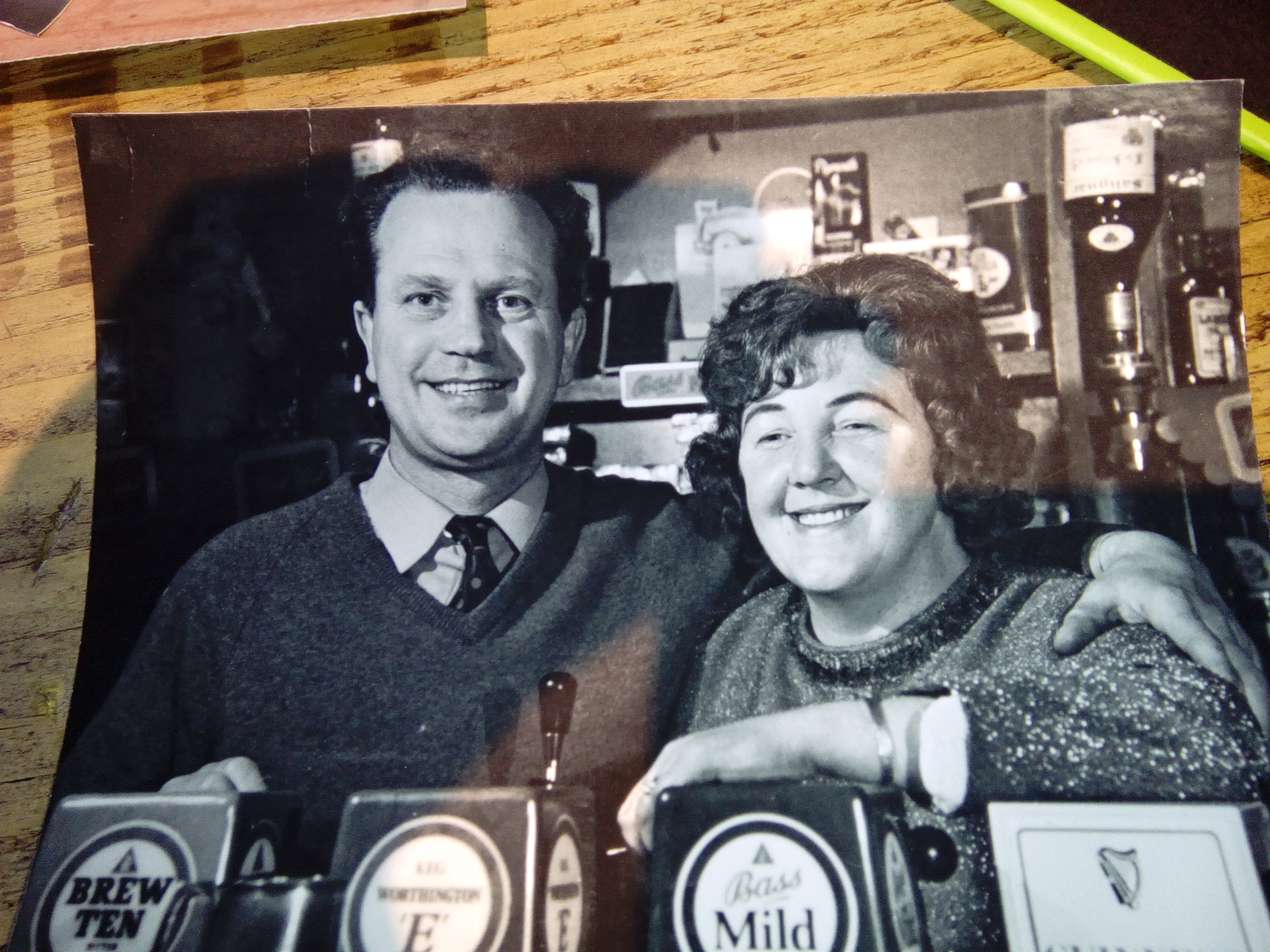
Nobody could argue that Tom Proctor was the dominant pioneer at Stoney from the back end of the 60s, right through the 70s. After Lucy Simmons and Our Father, Tom continued his onslaught of unlikely looking climbs; nothing was impossible to him. He told me that he looked at new routes in blocks of a few moves, maybe just three or four, and if you could do these then you looked at the next few and so on even if that went on for 100 feet.
The reputation of Stoney as both a proving ground and a social centre had spread wide and far. Numerous groups frequented the cafe, the crag and the local pubs. The North Staffs MC had been closest to us with two of them, Rob Hassall and Dave Sales joining the Cioch. Then, from just south of the Peak District, was the Ripley mob of whom Big John Cooper was closest to us and was special and much loved in that he had transport, a green A35 van. 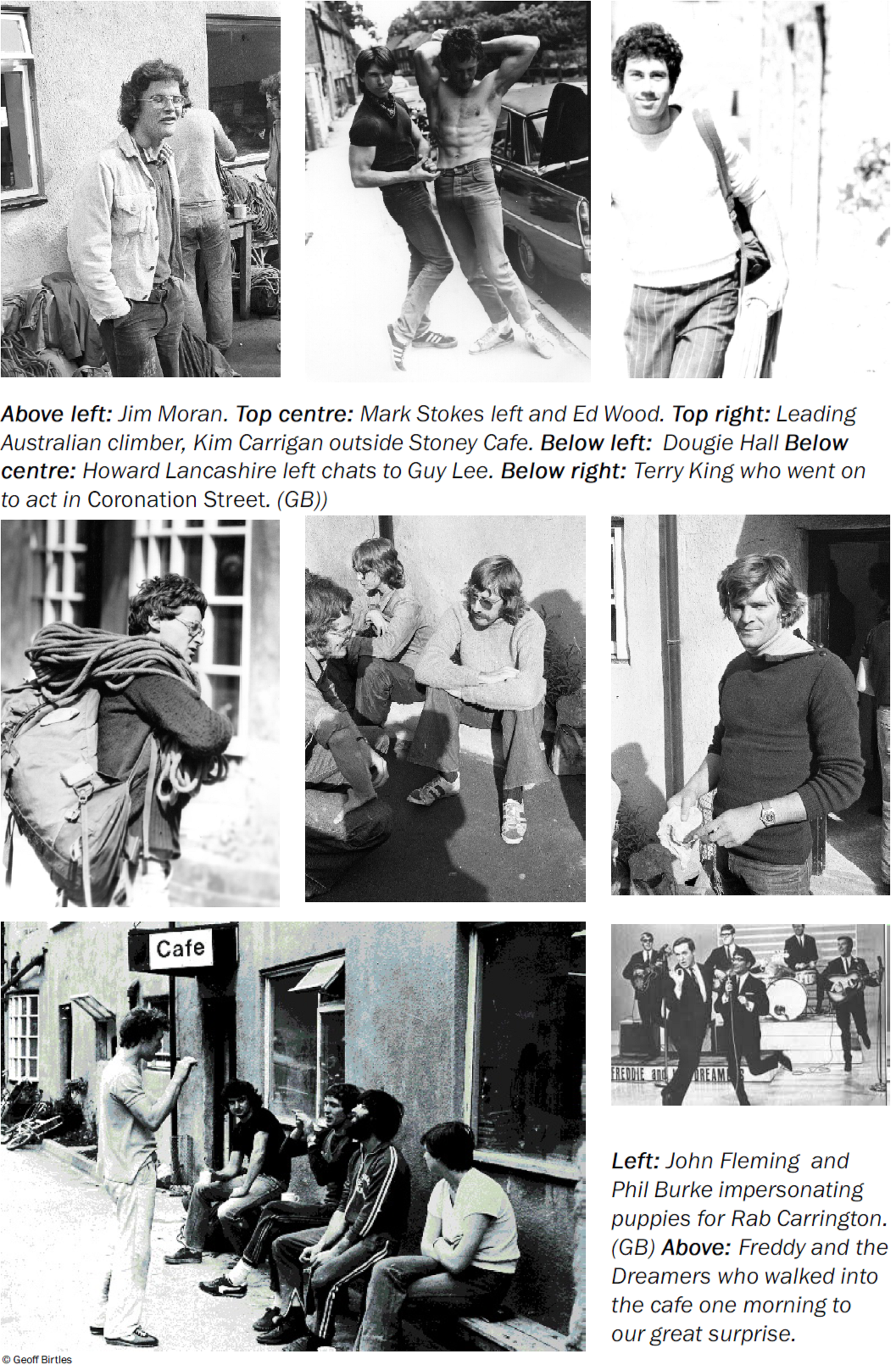
John was completely the wrong size for rock-climbing but had great enthusiasm. He was some 15 stone compare with my 9½ and he once pulled me right off the top of Rivelin crag when he fell off seconding and I had an ill-thought-out belay at an angle. As I was dragged on to the rock face, my hand using a waist belay was trapped between my body and the rock which ripped the skin off but I held him. His group made Stoney their weekend home with the likes of Ted Wells and M (Mouse) Barnicott.
Then there was the Notts MC with Doug Scott as a kind of leader. They held their club unity together for a long time and even ventured to the greater ranges of Asia on expeditions with Doug going even further. From Sheffield, whilst the Parnassus had a hut beneath ours, the Peak Climbing Club also frequented the crag with such as limestone pioneer John Loy and, to stay on as a 70s resident, Al Evans, who went on to greater things as a cameraman on Coronation Street.
Al and I became good friends and we climbed quite a lot together and co-founded Crags Magazine.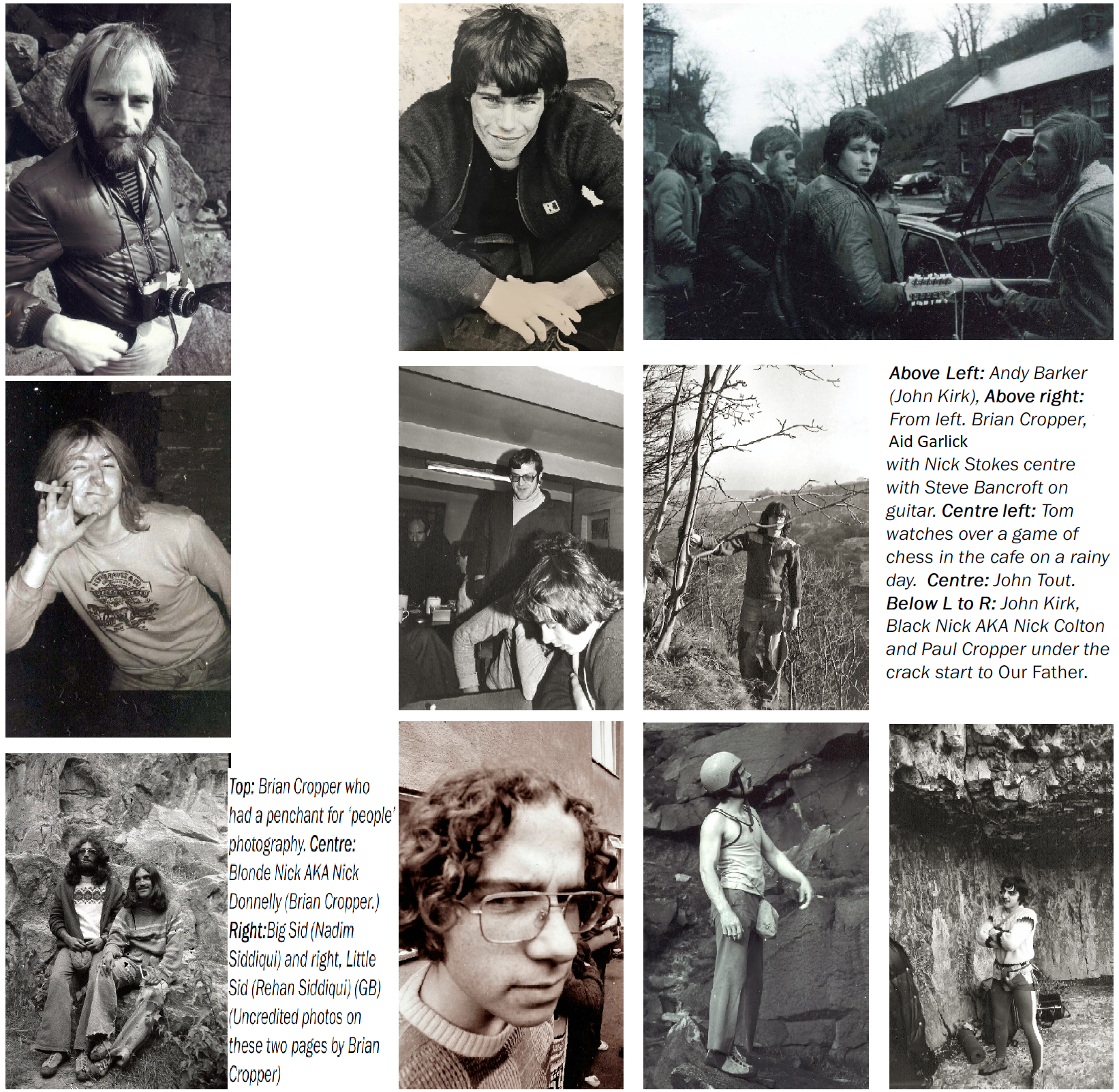
Working in Manchester he became an integral part of the climbing scene both there and in Glossop with such characters as the Regan brothers, in particular Gabe, Jim Moran. The Siddiqui brothers Big Sid and Little Sid, Black Nick, Blonde Nick and Brian Cropper. Another outstanding climber from Manchester was Danny Murphy along with his friend Mike ‘Hairy’ Peters
By this time there was no accommodation at Stoney other than natural bivvies but the Manchester lot who seemed late getting personal transport made the open woodshed by the cafe a dossing place. To the great credit of the local carpenters the Masons, who owned the shed, turned a blind eye on this and in turn I never heard of any damage. It would eventually become a second home to Jerry Moffatt when he made his move from North Wales to the Peak. The other dossing place was in the gents outdoor toilet at The Grouse, now demolished.
Walking the Dale
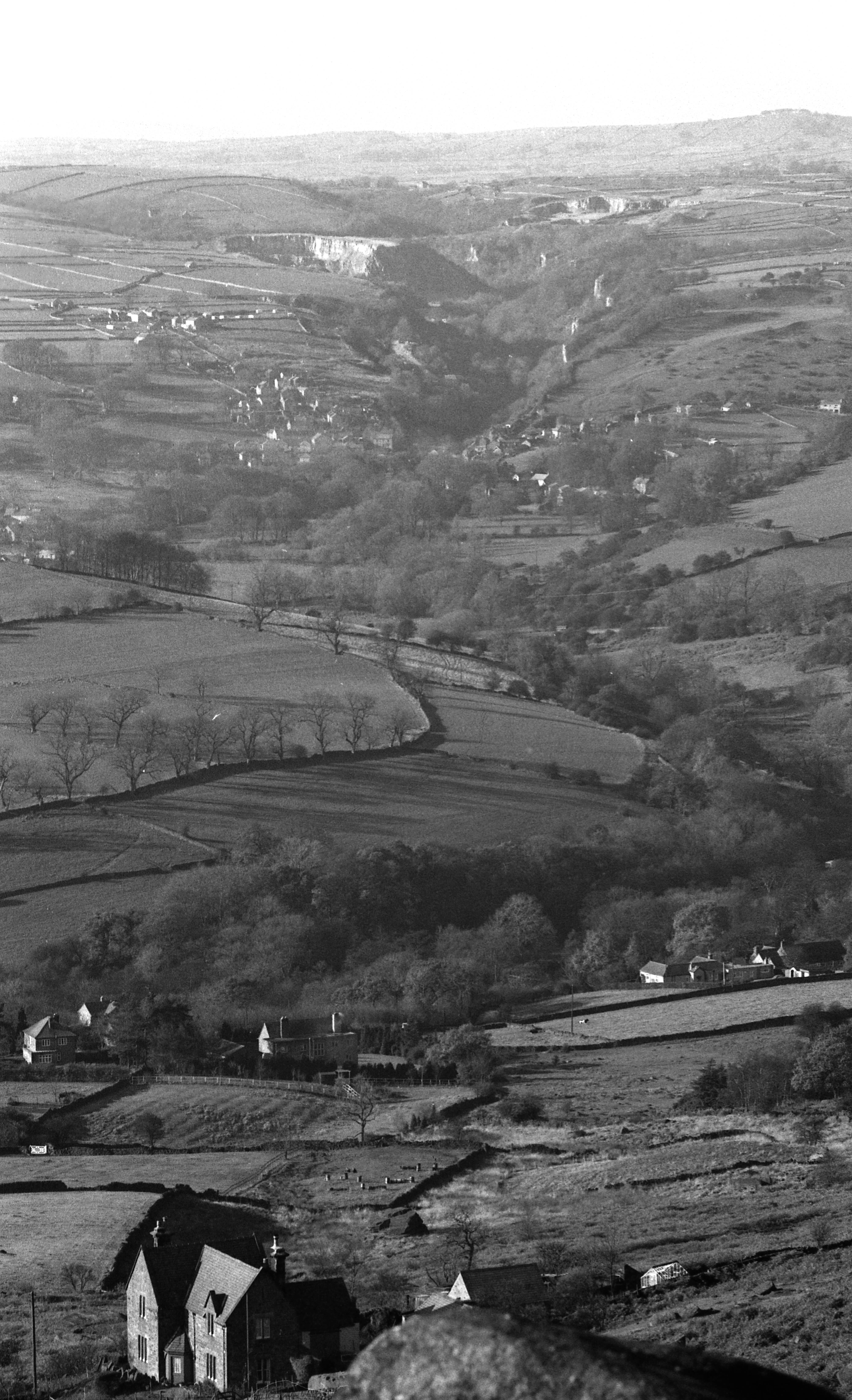
Records for the early part of the 70s are thin. Mountain magazine, which began in 1969 almost had an almost wanton disregard for Peak reporting despite Paul Nunn’s 1970 article 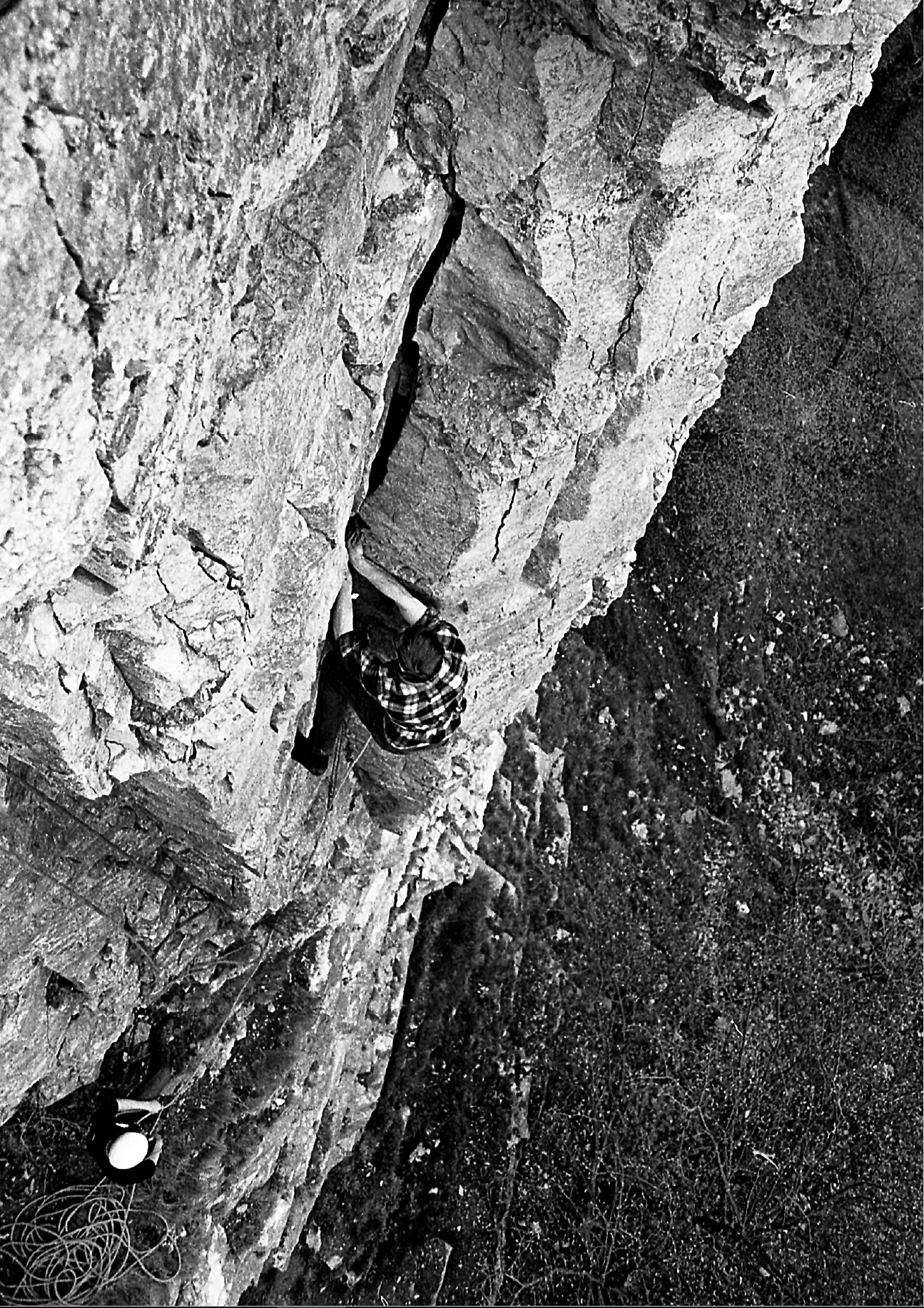
Guidebooks
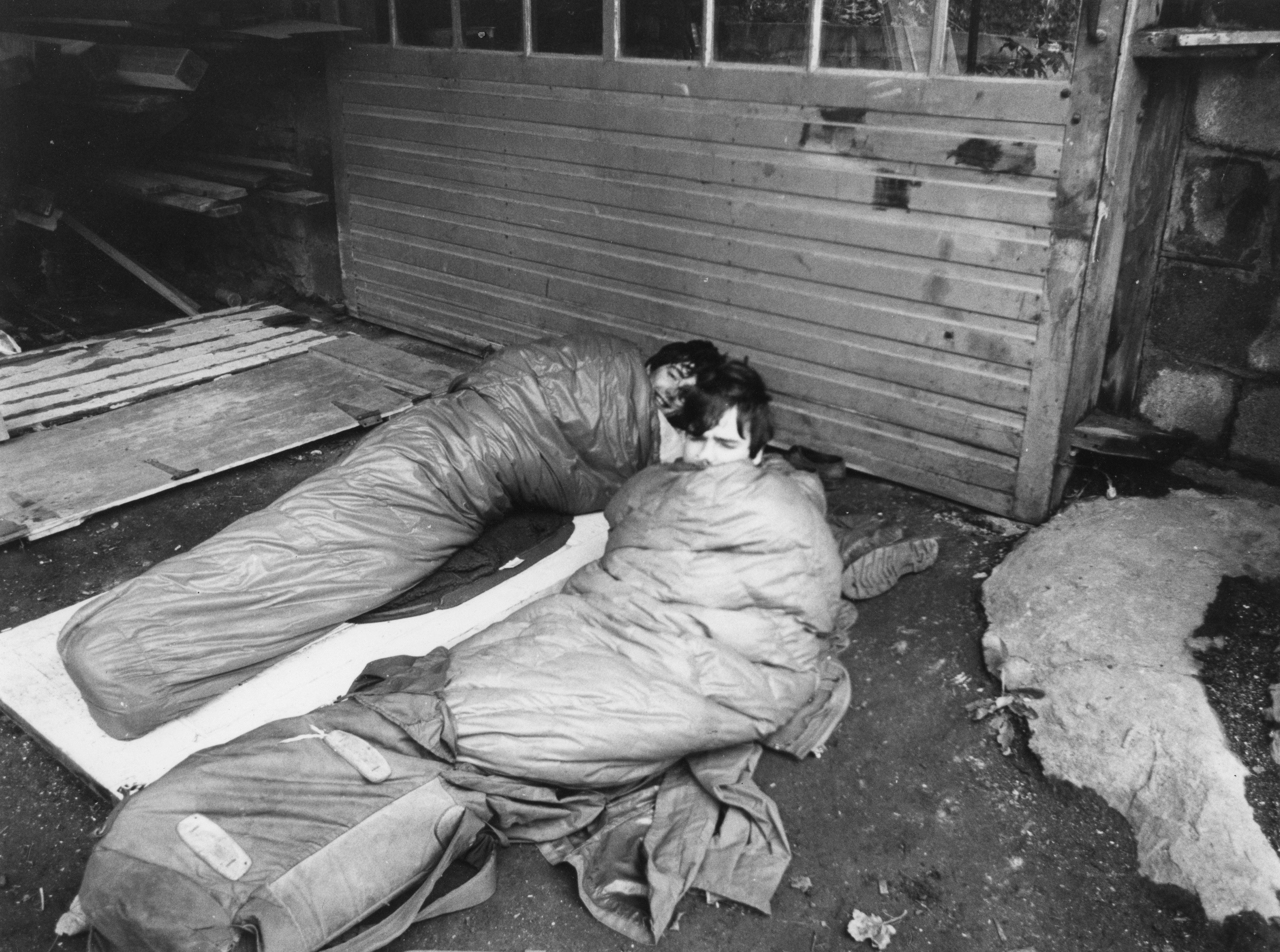
Just as Graham West’s 1961 guidebook generated interest in Stoney which indeed resulted with the Cioch taking up residence there, so, it seemed, did my 1966 guidebook. It was noticeable that new faces began to appear then and again after the 1969 CC guide. A new generation of Stoney devotees were emerging and as in all climbing communities, there were some rich characters amongst them, the likes of
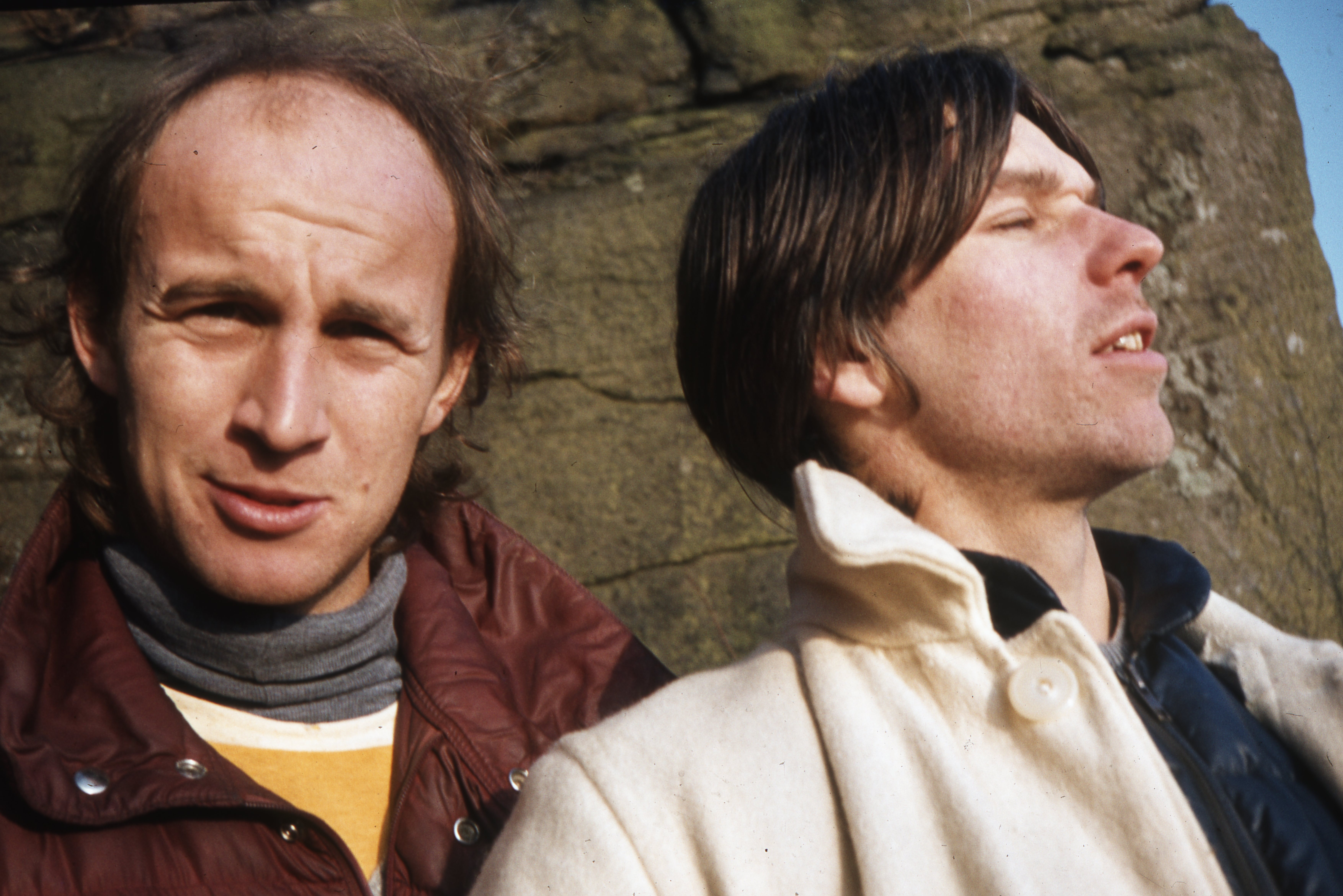
Steve Bancroft, John Allen, Keith Myhill, Gabe Regan etc; the list goes on from California to Australia. Hanging out at the cafe at Stoney on a Sunday morning was the thing to do. Even if I was going to Stanage which was close to my home, I would still go to Stoney en-route, mainly to meet Tom where we often ended up with a couple of poor schoolkids in the car wanting a lift in the shape of John Allen and Mark Stokes.
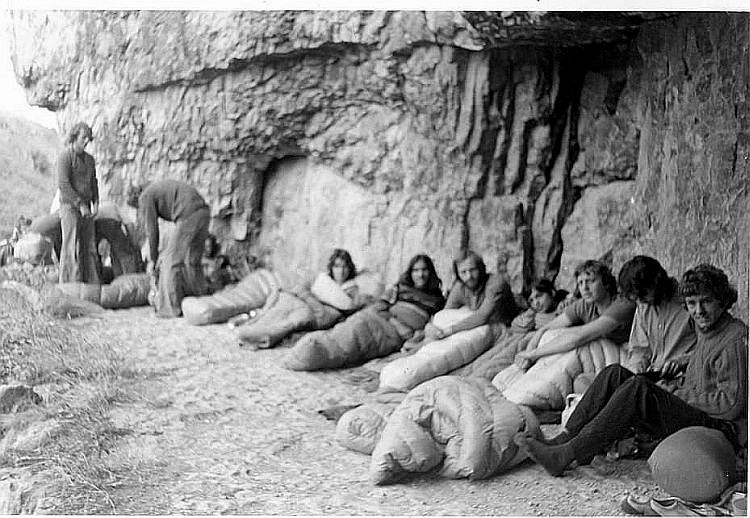
These were good sorties which usually resulted in us trying desperate new boulder problems which would repulse all efforts until a final success followed by the others repeating it straight away which was an indicator as to how ‘knowing the numbers’ made a climb that much easier. It was an interesting indicator as to how important ‘knowing the numbers’ is. The 1980 BMC guidebook edited by Chris Jackson included the 1970s period. Though I wrote the Stoney section, it was very much a joint venture between Tom and myself to the extent that, one day, we walked the whole length of the crag with the manuscript checking every description.
(There is a Bibliography at these histories.)
The Tom Era
The 1980 guidebook records:
‘This was the situation when the 1969 guidebook was published although the history was, in fact, written in 1966. Consequently, several notable routes climbed during the period between were slotted into the description but left out of the historical section. Of these, Jack Street made his final contribution with Boat Pusher’s Wall, Bingo Wall and his solo ascent of Solitaire.
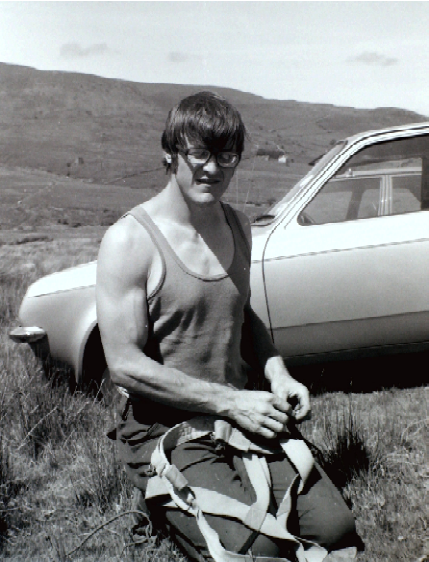
Development from around 1967 to about 1980 repeatedly centred on Tom Proctor who seemed to have undertaken possession of the crag successively producing harder and harder routes. His name was omitted from the history of the 1969 guidebook although some of the routes were included.’
A further testimony to Tom appeared in a report by Mike Browell in the 1979/198 CC Journal:
‘Tom Proctor still keeps the world at bay with a perennial crop of desperate routes. Of the 1979 harvest, few have been repeated but of those that have, My Girdle is Killing Me ranks highly. Colonel Bogey and Four Minute Tiler are particularly fierce and seem destined to become the next decade’s test pieces. Few other climbers have succeeded in penetrating the Proctor domain but Geoff Birtles is one of the chosen few and took the lead on Black Teddy and on Oliver, an instant classic steep wall climb in Stoney Quarry.’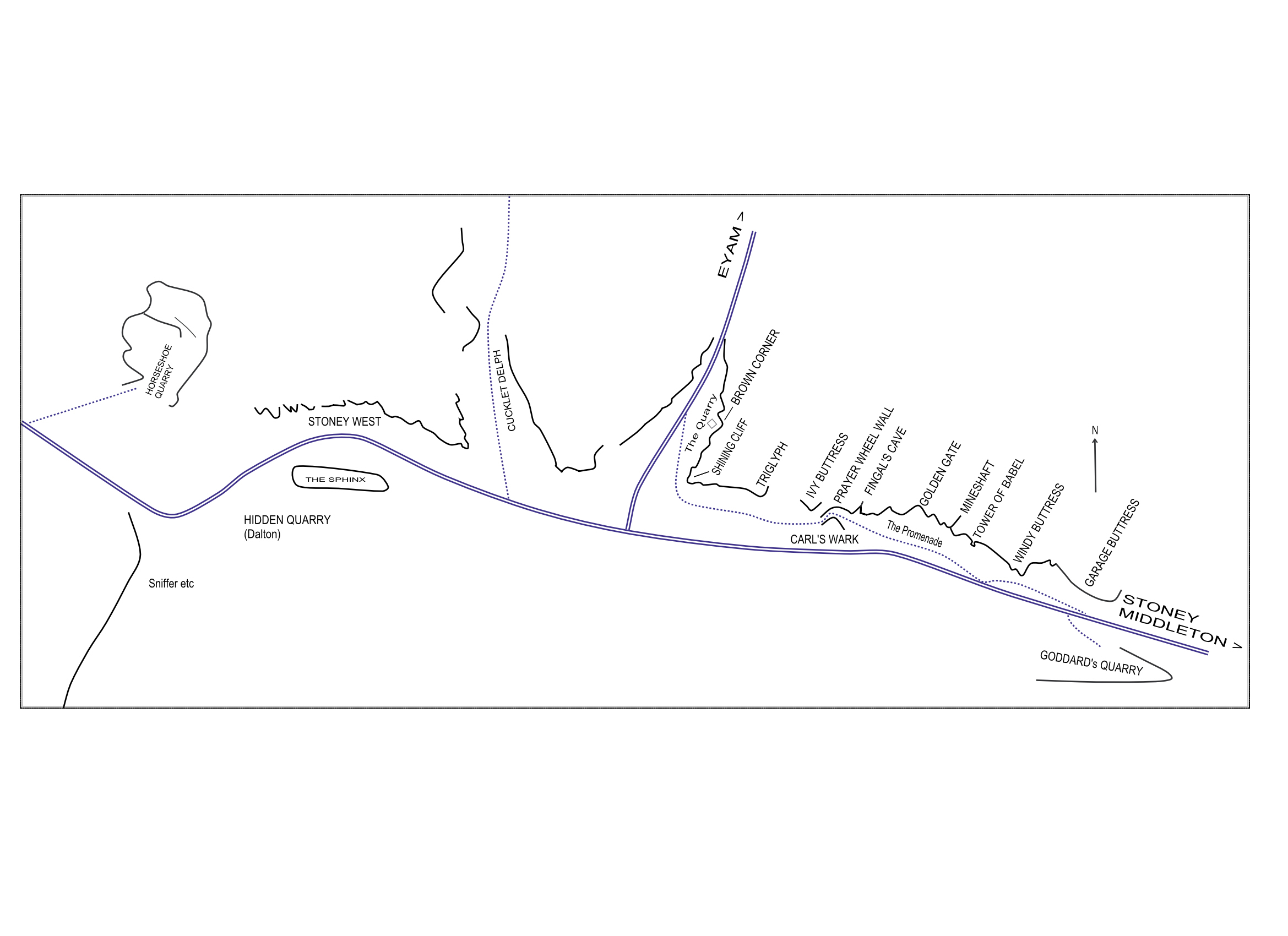
The 1961, 66 and 69 guidebooks all described Stoney routes from left to right which Tom and I thought was illogical as you invariably approached the crag from the village and, therefore, the right, so we changed it in the 1980 guide to read right-to-left, something that rather sensibly Neil Foster also did in the 1987 guide. However, in the recent 2015 Peak Limestone North, it changed it back to read from left-to- right! Meanwhile, let’s walk up the dale: right to left.
Garage Buttress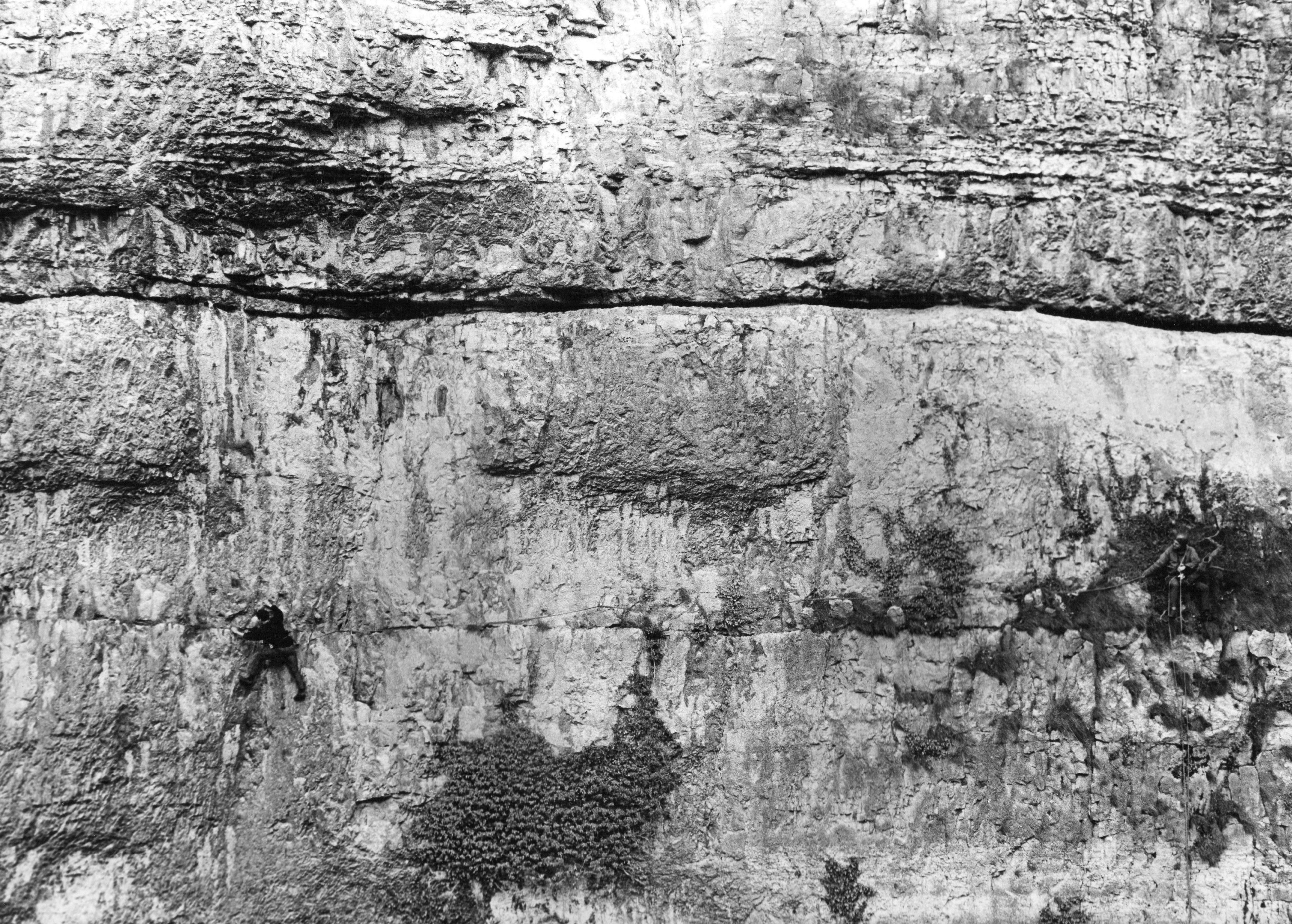

The largely natural crags are on the right as you go up the dale from the village; the first buttresses probably being the best bits of unclimbed rock in England but, as people live in houses directly beneath them, they are likely to stay that way. Continuing, we get to Garage Buttress which is immediately beyond the garage and former filling station on the right and is the first buttress on which we are allowed climb though one quiet Friday evening, I soloed the obvious, very vegetated, gully in the back right corner of the garage forecourt which went fine until on the upper slope where I dislodged a rock which landed on top of the corrugated tin roof of a long-gone building. The noise was so loud that I fled along the top and descended some way away and strolled innocently down the dale but the incident seemed to have gone unnoticed as there was nobody around.

The most distinctive feature of Garage Buttress is the great horizontal rake at about three quarters height which crosses its whole length and is the line of the excellent Pendulum. Part way along the lower wall is the site of Flycatcher which Tom did in 1978. It is E4 5c, an amenable grade for many but the snag is that there are no runners worth having which made it a no-go area for everybody for some 15 years.
Sadly, Andy Pollitt’s adjacent route, Virgin on the Loose used a bolt runner and as the guidebook says, this bolt now protects the crux of Flycatcher which rather takes away the whole scary point of the route. I don’t think that was ever Andy’s intention and decades later, in response to my suggesting that maybe the bolt should be moved a few feet to restore Flycatcher’s integrity he replied from Australia: ‘Yes, a good idea, can you arrange that?’ [I’ll ask Gary?]
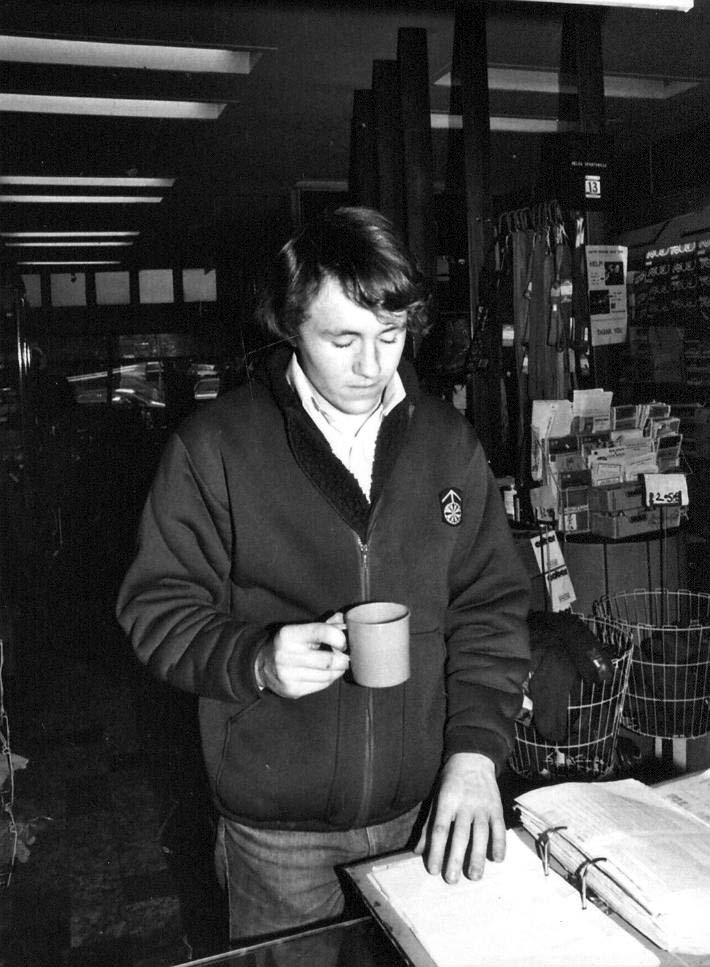
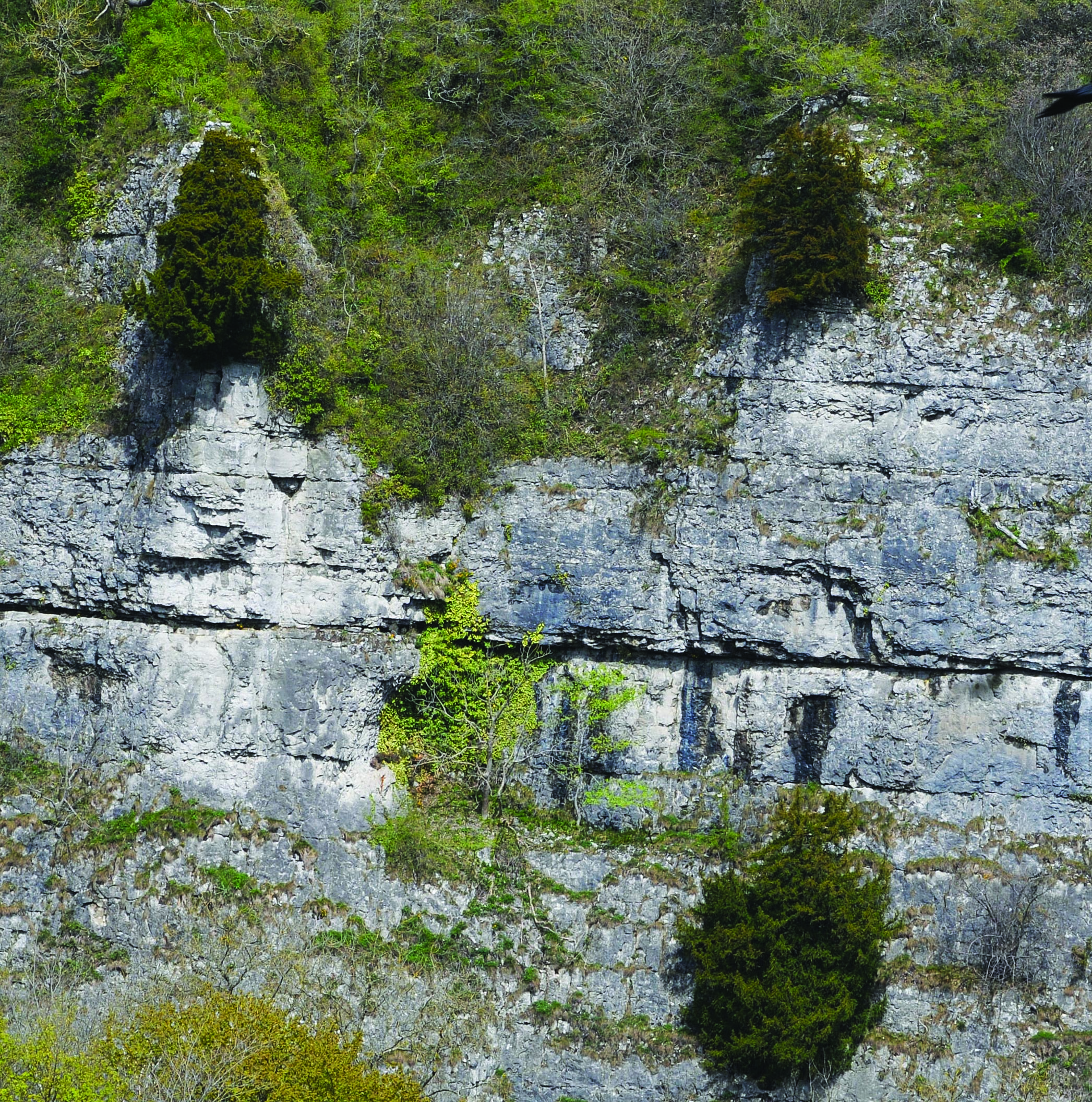
Another major route by Tom was Four Minute Tiler which was a steady climb apart from the first move above Pendulum which involved placing a jam in the break, bringing one’s feet high and leaning backwards whilst reaching full height to push one’s fingers under a flake which looked like it should fall off.
Then you released the jam and unfolded yourself upwards to reach a normal hold. It was really scary just seconding. If the hold had failed, leading it would have meant a spring loaded projection backwards into space and then hitting the ledges below. Sometimes, Tom had a great propensity for dealing with danger and this was one of those situations. Again, nobody rushed to repeat this for some time.
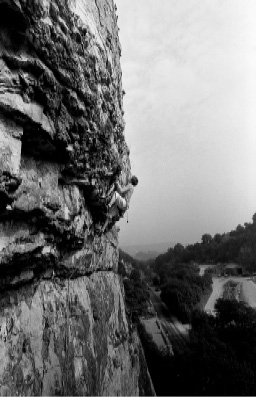
On a lighter note, a high level girdle of Garage Buttress had been done with aid some years before. We did a free version which was written up in Crags June 79 as: My Girdle is Killing Me 250ft E4 6b Start in the bay right of Compositae Groove and follow a natural line R to finish up Little Plum. Hanging belay in Helicon.
The climbing is excellent, and the rock is some of the best on the crag and the situation exciting if not daunting tip-toeing across the lip of the roof of Little Plum and I never saw anybody ever bother to repeat it. I hope they did though.
The rock in this area of Helicon above the break is extremely good and we did other routes such as Colonel Bogey; all good routes.
Another random contribution was by Alan Rouse, a surprise kid on the block who had previously stunned us all with his solo of The Boldest on Cloggy.
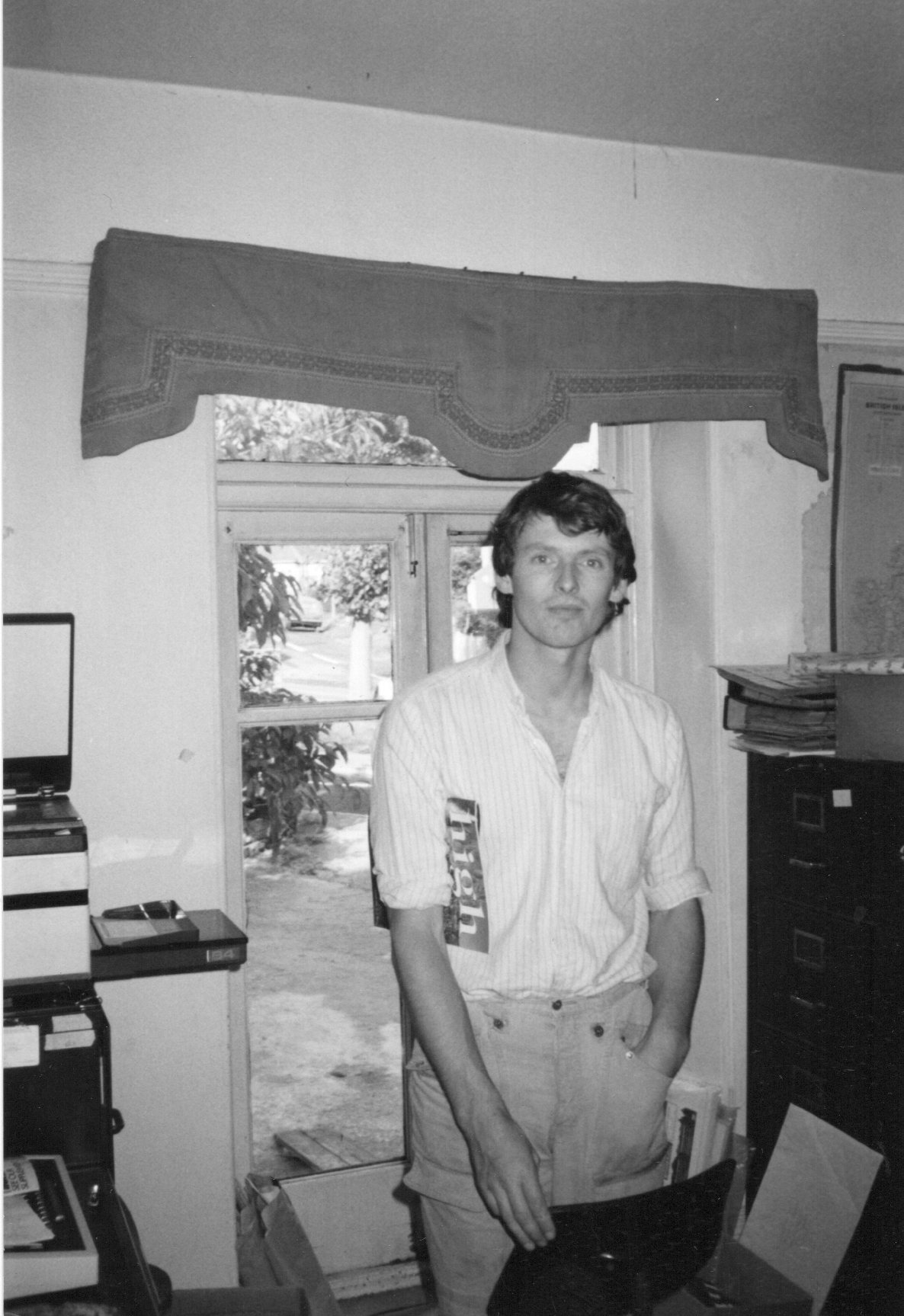
He turned up one Friday evening in 1970 on his first visit to Stoney. I had just done the West Face of the Blaitière with him that summer which had been our only acquaintance and that evening we teamed up again and I led off up some scrappy rock to the break on the left side of Garage Buttress. From there, he led through on the upper wall which was to become Matrix E3 5b which was a good effort as he wasn’t particularly familiar with limestone and had never seen the crag before. He is also credited in the 1987 guidebook history with doing Cabbage Crack
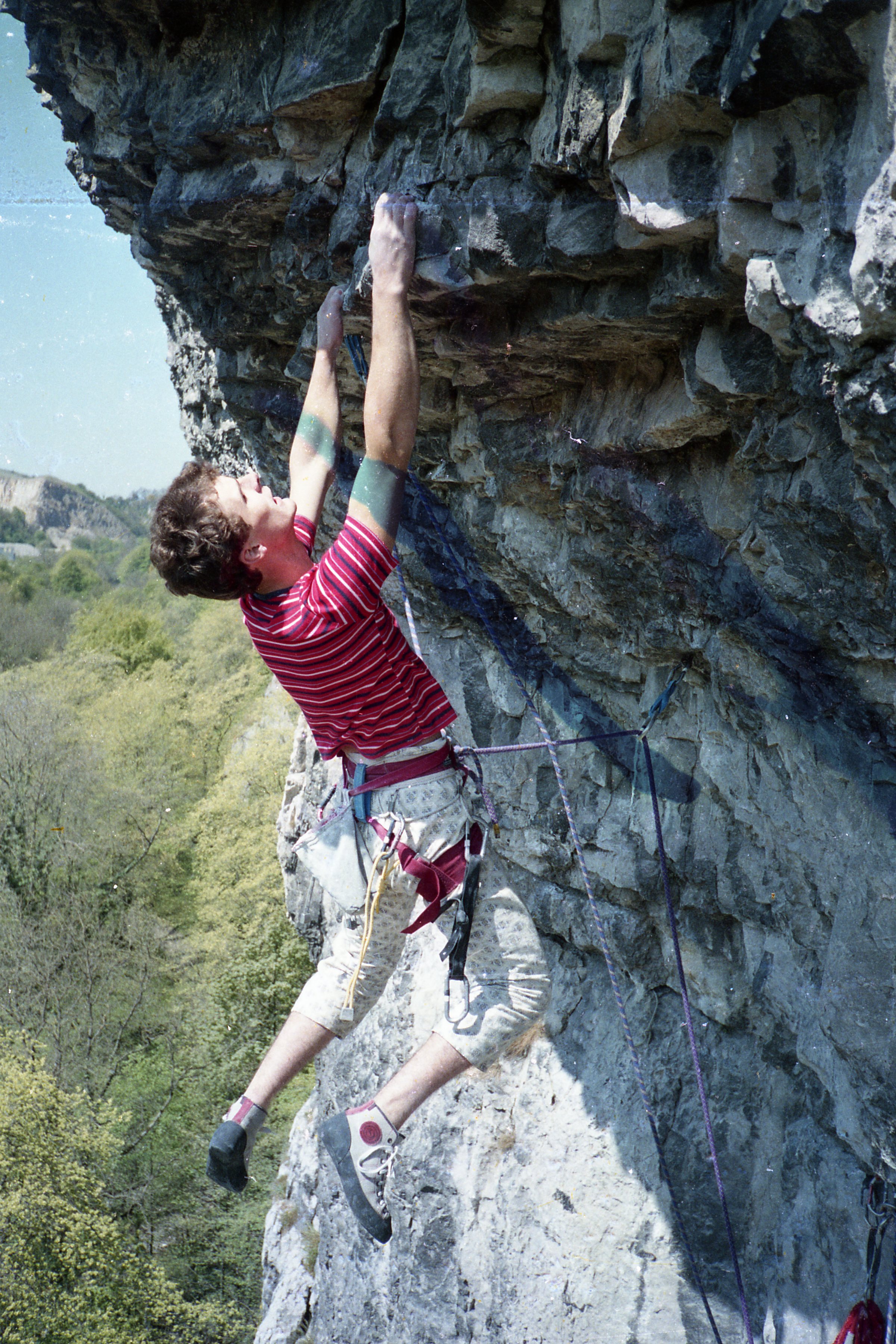
years later without a point of aid which Tom had used when he did it, the route having been an aid climb previously. Tom is also credited with doing it free in the June 79 issue of Crags so take your pick.
At the left-hand side of Garage Buttress between that and Windy Buttress is the scrappy tower with the rightward slanting crack line of Blue Banana. A few other routes were done here but none of them memorable.
Though we had done various climbs on Garage Buttress, a free version of Little Plum was high on our agenda but more about that at the end of this piece.
Windy Buttress
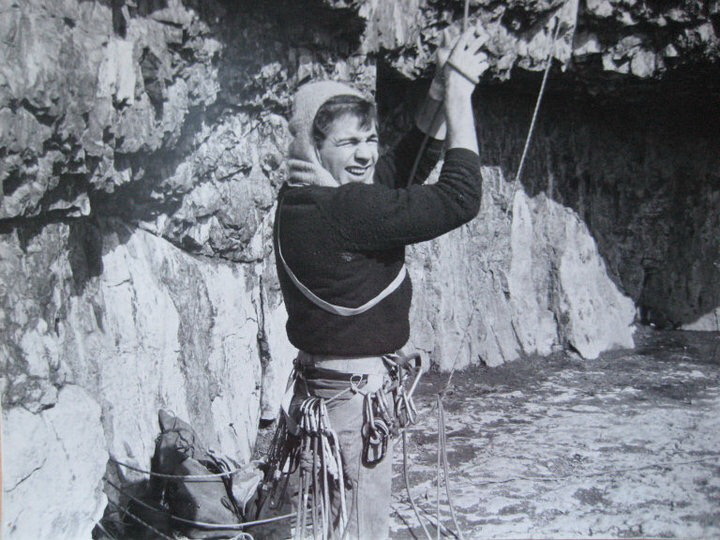
And so, we now arrive at the magnificent Windy Buttress, arguably the best bit of Stoney and the highest rock buttress in the Peak District at 167 feet and yes, I did go and measure it with a tape.Apart from Our Father, mentioned elsewhere, Tom made some magnificent contributions such as Scoop Wall free, a really excellent climb. I was supposed to do the bottom pitch on which I failed after reaching a point just below the cave when I missed a side-pull and went brain-dead as to how to move up and concerned that my last runner was some way lower on the flake. I eventually down-climbed to the runner and lowered off and Tom then climbed it which was very annoying when I seconded it to find the move quite straightforward.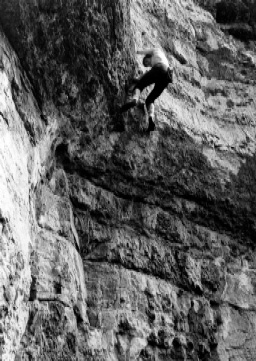
The ‘cave’ on Scoop Wall is, in fact, not much more than a recess but it provides a comforting if not airy belay ledge to several routes. Scoop Wall exits left (looking up) and a hard move gains a groove to finish.
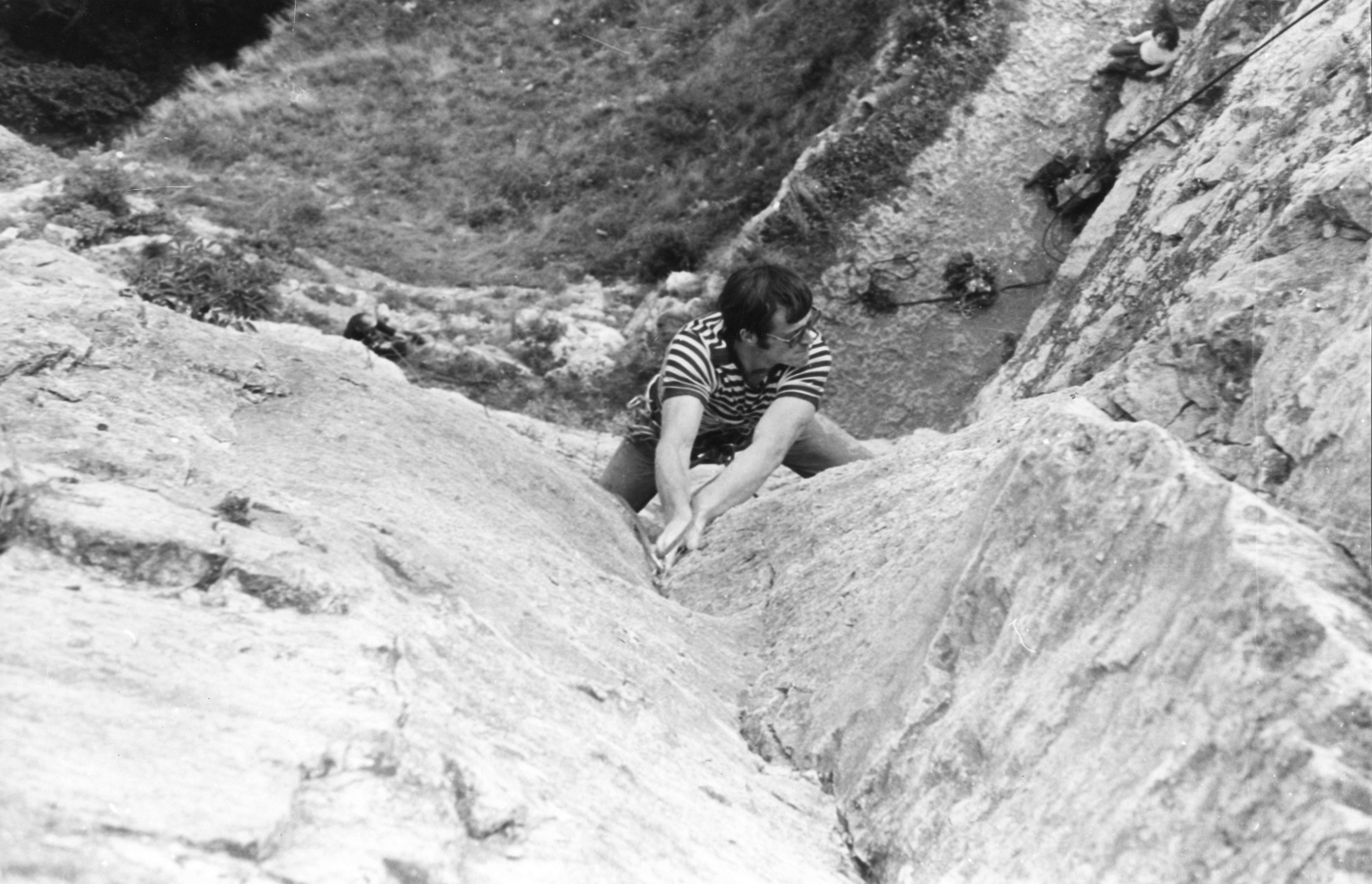
Menopause
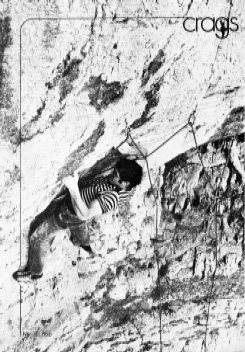
Tom’s final attempt at new-routeing at Stoney ended with a torn finger ligament on Menopause, the shallow groove which exits the cave, high on Scoop Wall and originally climbed by Al Evans with some aid. A John Kirk photo of Tom seconds before his injury appeared on the front cover of Crags magazine 21 and is now displayed on the wall at The Moon Inn.
It remained for a leading young climber to take up the challenge on Menopause in the shape of Chris ‘The Flash’ Hamper. It was recorded in Crags 25 June 80: ‘Chris Hamper has stolen the glory from Tom Proctor by snatching one of the biggest challenges at Stoney Middleton – a free ascent of Menopause. Hamper did not climb the first pitch but abseiled into the cave. He managed to climb the bulge and groove on his first attempt and also managed to dispense with Proctor’s jumping move, preferring to pull up on one arm instead.’
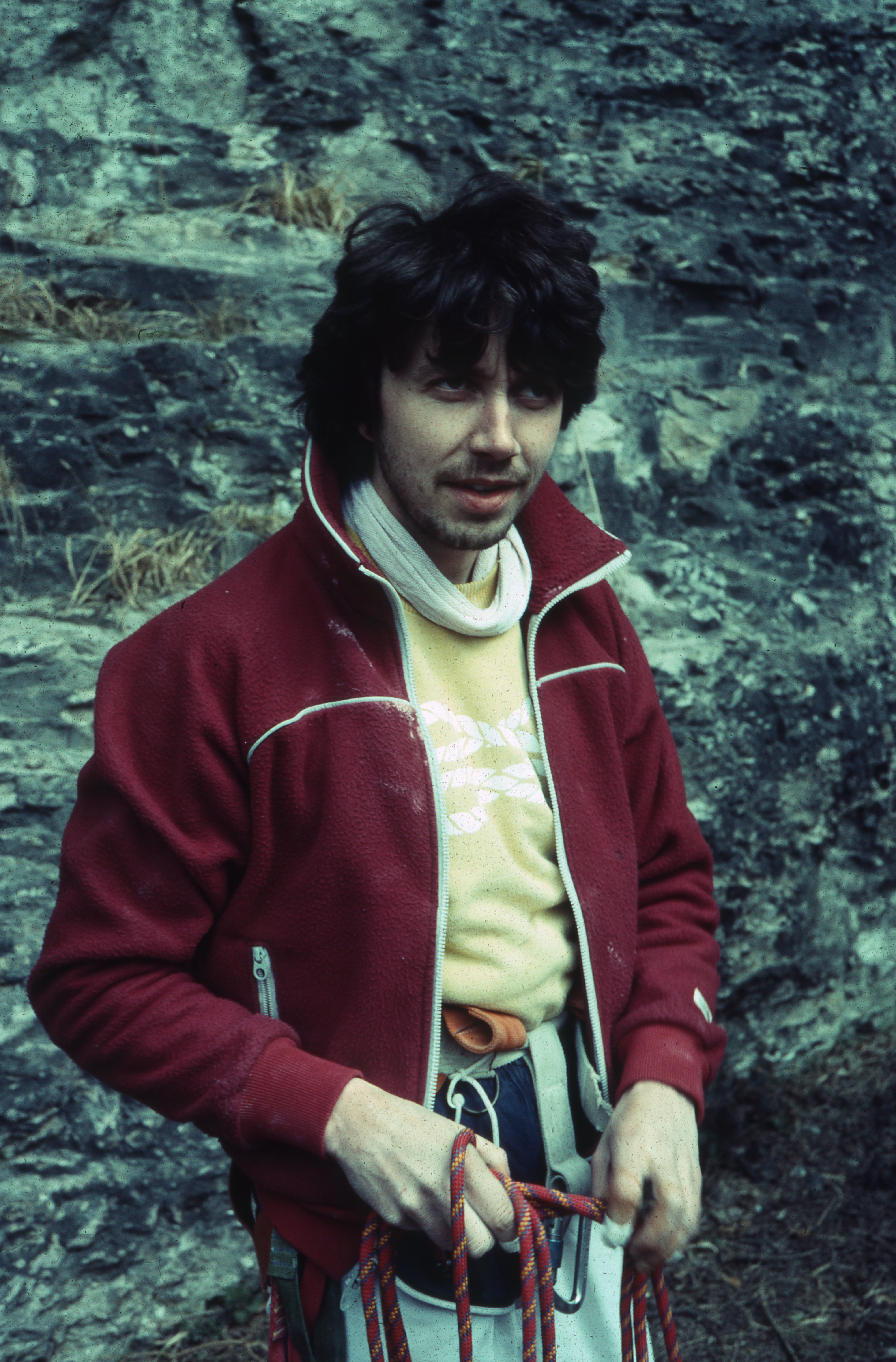
Chris, who subsequently became resident in Norway has sent his recollections and when I asked him how he got his nickname he admitted: ‘It was Bernard Newman. I think he gave all the Leeds climbers their nicknames. I thought mine was because I flashed everything but when I asked him he said: “ Naw! Flash in the pan, I’ve seen ‘em come, I’ve seen ‘em go”.’
Chris continues:
‘I have quite a lot of memories about Stoney. When I was young (14 -16) my dad would drive me and my mates to the Peak but we would only climb on grit (mainly Stanage) and would never go to cafes (or pubs obviously). Actually we did go to Stoney once, I did Fe-Fi-Fo-Fum and thought it was very polished and didn’t like the place; close to the road though.
Later, I heard of Stoney in the mags, read about an undercut hand-jam which I imagined to be a vertical crack that was jammed with the hands pointing down. My mind boggled, Tom was my hero.
When I was about 17, I went there with Bill Turner, a friend who was studying at Warwick University. I thought Memnon looked less polished than other stuff but failed on it. Tom Proctor turned up and soloed up to get our gear down. We were going to leave it but he didn’t like gear hanging from the crag.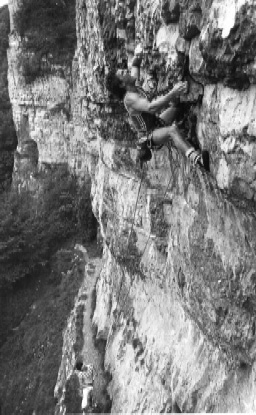
At Uni, I was introduced to Stoney proper by Steve Bancroft and we did all the classics: Boat Pushers, Wee Doris (took the well documented fall), Our Father (discovered it was a jam in an undercut not an undercut jam), Kellog etc. I also learnt how to play the cafe games and where to sleep, mostly in The Moon toilets but got scared when Webbo told me that Con Carey once peed into someone’s ear. Then I moved to the safety of Windy Ledge.
Having “done everything”, I didn’t go to Stoney for a bit but returned to find John Kirk and his mates ruling the roost. He pointed me at some of the new additions such as Traffic Jam, Scarab etc and I did most of them.
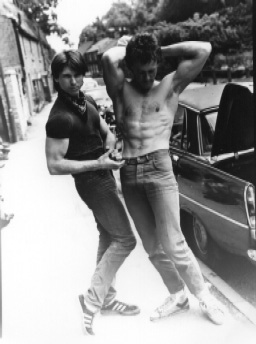
There were a bunch of people trying Circe so I tied on. Well, I thought I’d tied on but had only tied on to one rope. I had been too busy chatting to my old mate Banks who I hadn’t seen for a while. He belayed as I climbed past the old bolt and launched out across the traverse where I fell off and came very close to the ground. I was a bit cross with Steve for dropping me but let him off when I saw the hanging end of the rope.
I’d fallen off but knew I could do it. I was working in Coventry at the time at the same school as Bill Turner from where, in the summer, it was possible to drive up for an evening. We must have had the afternoon free or something ‘cos we arrived earlier than the evening and did Circe quickly just as Geoff Birtles walked past. I was wearing a pair of my dad’s old trousers. I had a thing about not looking like a climber. He took a photo.

Circe wasn’t the real reason we were there. There had been a photo of Tom trying Menopause on the front cover of Crags and talk about a one finger pull-up. I can do that I thought and I did. We didn’t do the first pitch as it looked chossy. Someone probably told me not to bother. The guidebook says I did it on-sight. The definition has changed. I abbed down to the belay and saw the pocket I had to reach for though I didn’t practise any moves. Then I did the route first try. Don’t think it would count these days
I also repeated Four Minute Tiler. I guess I flashed that too, I used to flash most things being too scared to fall off. I’d ticked Stoney again so gave it a rest until Hysterectomy and Little Plum. I couldn’t do the former but got the first one-day ascent of the latter. I simply jumped the crux on the first pitch and the second was easy. After that I don’t think I ever climbed at Stoney again though went to the cafe a lot.

The cheese and beans on toast was very special. Have often tried to recreate the texture of the cheese as it combines with the tomato sauce.’
Also emerging from the cave on the right side was Hysterectomy climbed by Jerry Moffatt in 1981 and referred to in the Browell/Milburn history of first ascents as ‘Dubious tactics – a long in-situ sling clipped on first ascent was changed for a shorter one!’
Jerry takes exception to that and has sent the following:
With regards to the sling…
No dubious tactics were used. Noddy placed the peg which I think we took of an aid route in the quarry. I had not placed a peg before so didn’t know how to do it , he used one of his slings to lengthen the peg to clip it. Dougie Hall watched me do it from the ledge.
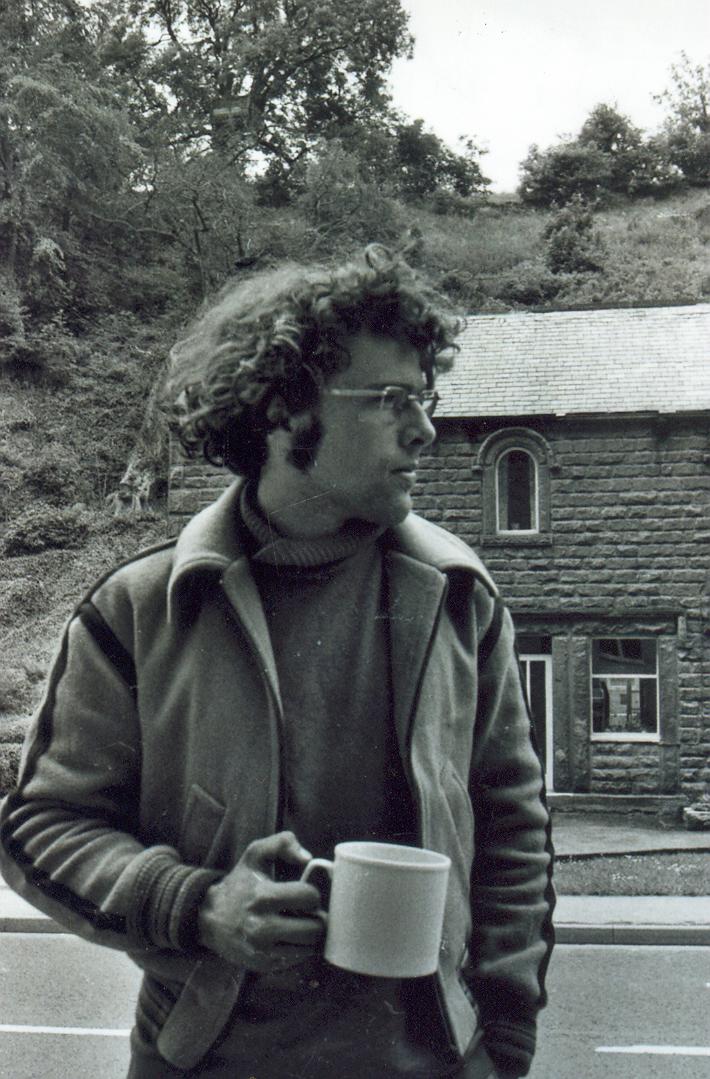
A few days after I did it, Noddy abbed down and got his sling back replacing it with another which I gave him. It was a different colour but still there, extended, so people could clip it. same length. I think Dougie being a short ass struggled to clip it and claimed incorrectly I had a longer sling on it.
That is the God honest truth!
Now we go round the corner to another Tom route, Special K at E4 6a which took the wall just left of Windhover, a scrappy difficult and scary start and then steady with the pleasure of pulling round the overlap to cross Armageddon.
Left again are the two prominent leftward slanting grooves of first, Kingdom Come and then Kellog. Both of these were old aid climbs. According to the August ‘68 edition of RockSport: ‘Tom Proctor and Geoff Birtles have been having a blitz at Stoney Middleton, Tom Proctor, seconded by Geoff Birtles has reduced the aid on Kellog to one bolt at the start.’ This was later freed. Kingdom Come was also done by us with an aid point at the start which was eventually eliminated by John Kirk and his brother Paul.
Kink
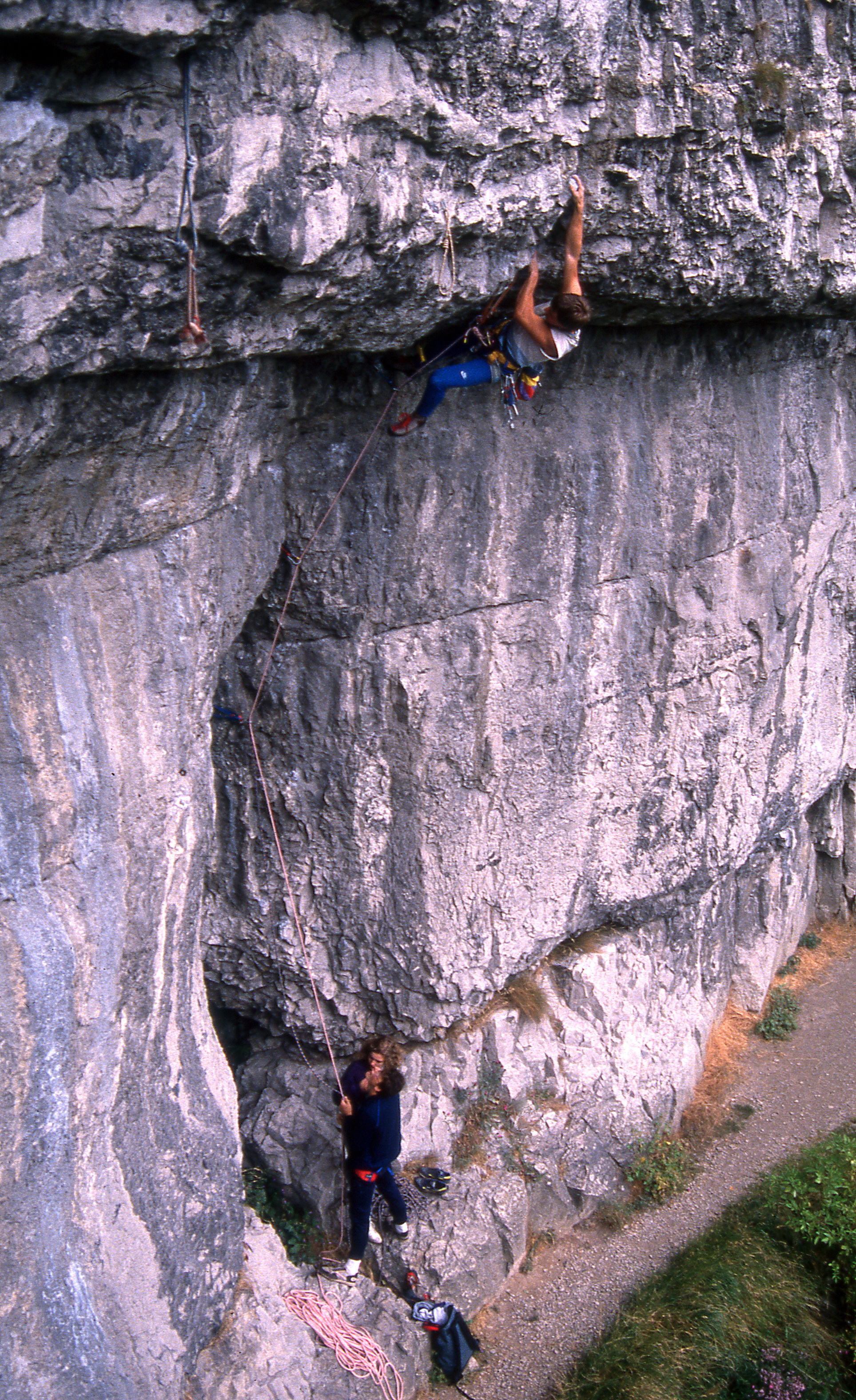
Tom did the unthinkable and free-climbed Kink (aka Brown’s Overhang). Although it looks horrendous, it turned out to be a really good climb and I did the second ascent finding it surprisingly amenable, a lean back on the roof with a good jam to reach the holds at the lip and then some thuggery to pull round.
Tom also tidied up a couple of more routes there, Circe
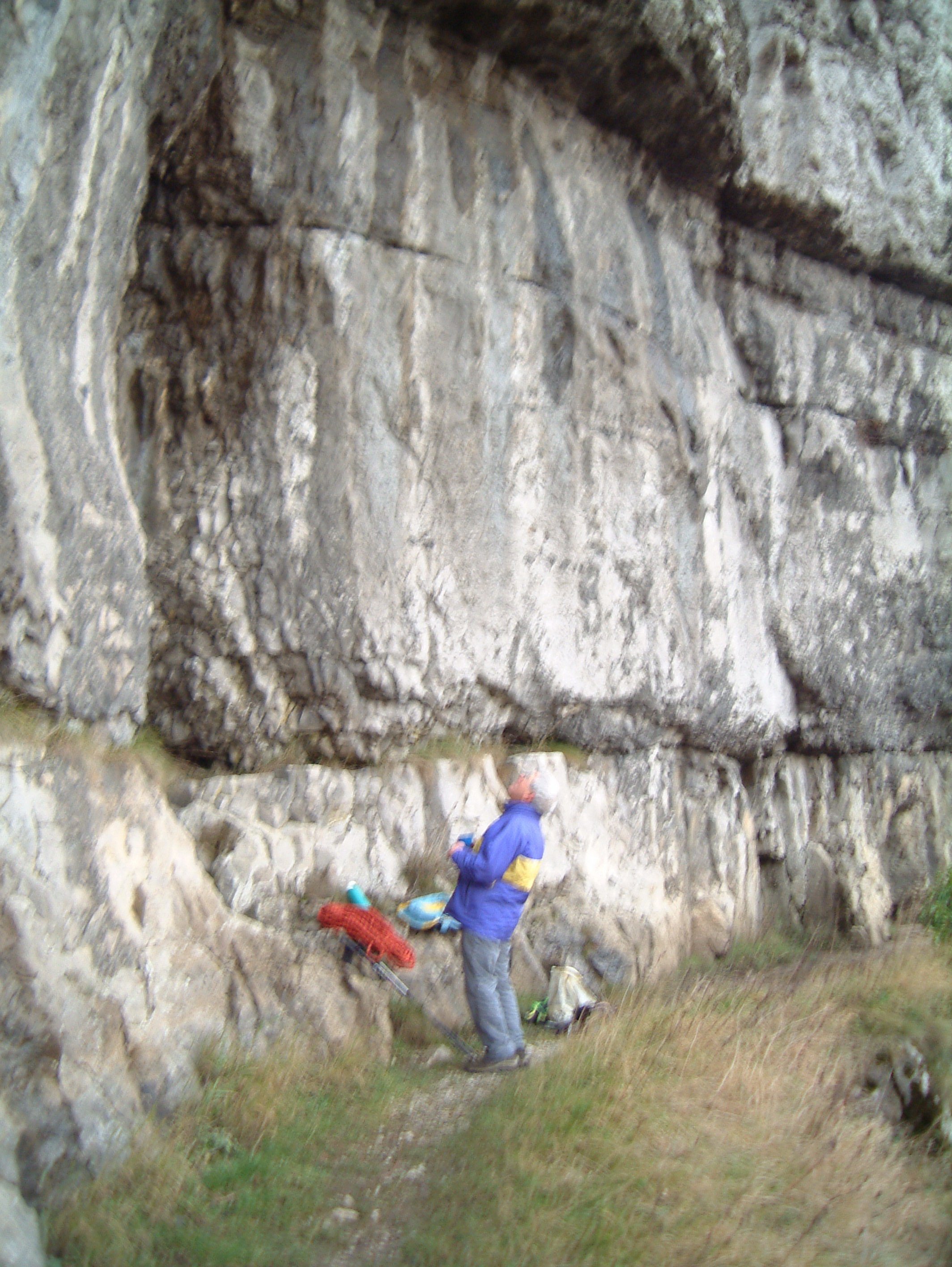
and Inquisitor, which I had done with a point of aid. Circe proved to be a popular and challenging test piece. There was a bolt in the climb from its first aid-ascent which now looked past its sell by date and I put a new one in alongside which I don’t regret and never saw anybody ‘not’ clip it as beyond are some hard and committing moves with the last runner someway below and the potential of a ground fall on to the ledge.
A great quality climb from the Ledge was the free ascent of Dias Irae by Tom with Mike Peters. This is excellent face climbing all the way with enough natural runners and a peg half way where Alcasan crosses.
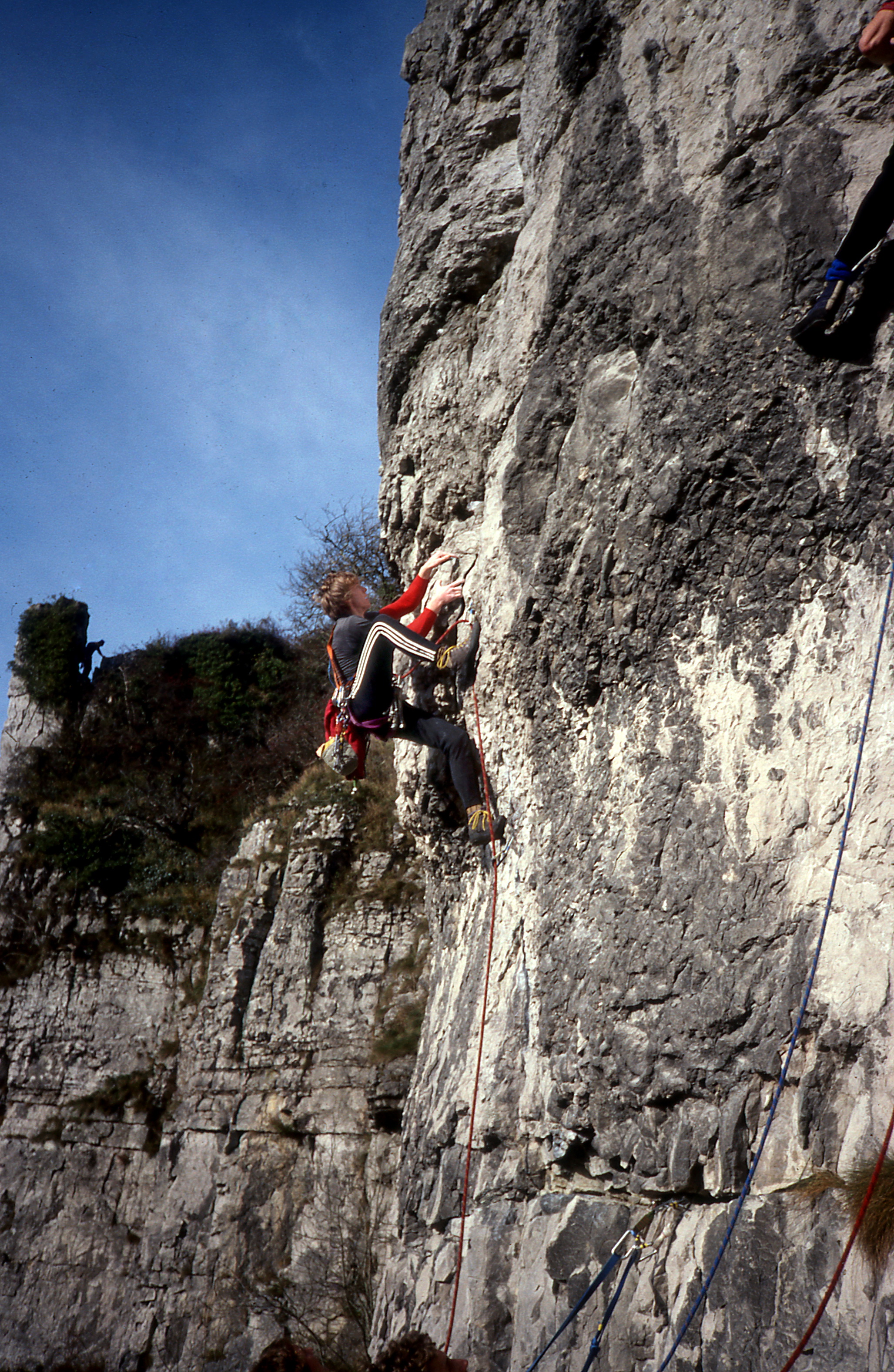
My last contribution on Windy Buttress was Black Teddy which started up Inquisitor until it was possible to step right above the bulge, The rock is superb and the climbing at E2 5c is as good as Dies Irae and better than Inquisitor. Note that the diagram on page 60 of the 2015 Peak Limestone North guidebook is wrong as Black Teddy goes straight up after stepping right and Dies Irae is virtually a straight up climb from the ledge.
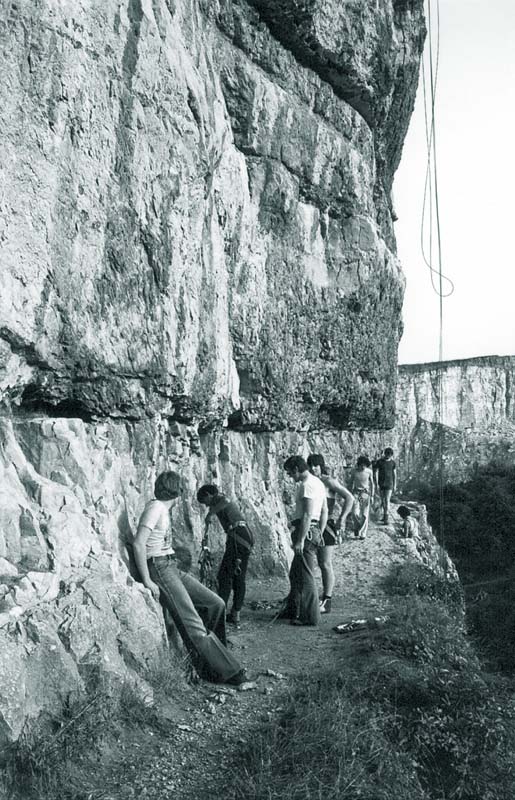
The Tower of Babel
The next buttress along the crag is the Tower of Babel which crams into such a small space the three great routes of Glory Road, Sin and Lucy Simmons which is covered elsewhere. Magnificent though this tower is, these are the only three worthwhile routes though the rather grotty Truffle on the right side was the scene of some passing interest. Ken Wrigley, a Sheffield member of the Parnassus and metallurgist recalls a discovery:
About 1973/74. I was attempting to lead Truffle to the right of the Tower of Babel. It was dreadful and every hold came away in my fingers.
I chickened out about 20 or 30 foot up and rescued the climb by traversing left along a horizontal break to finish up what the old Northern Limestone guide described as a ‘much vegetated corner’.
My second, a work colleague called Brian Benson, found an unusual piece of metal jammed in the corner crack, and took it away with him.

It sat on Brian’s desk at work as a paperweight for several months when he got bored of trying to work out what it was (a piece of string wrapped around the groove gave a nice inverted parabola when length was plotted against rotation).
One day, out of the blue, Fred the Departmental Instrument Technician, happened to be in his office, picked up the piece of metal and declared “Haven’t seen one of those for a long time!”
Turns out the piece of metal was a component from a bomb sight computer. The parabola was the trajectory of the dropped bomb. (Fred had learnt his trade as an RAF Instrument Technician).

Ken suspects it was from the bomb aiming device fitted to the war-time Wellington bomber. He and I went out to Stoney and descended the slope above Truffle but found no traces of a crashed aircraft. As many climbers hereabouts worked in Sheffield in the steel industry, maybe it was a piece of metal that a climber had taken there with a hope of jamming it in a crack or maybe it was related to an aircraft that crashed on Eyam Edge during the Second World War. I doubt we will ever know.
Tom’s Roof
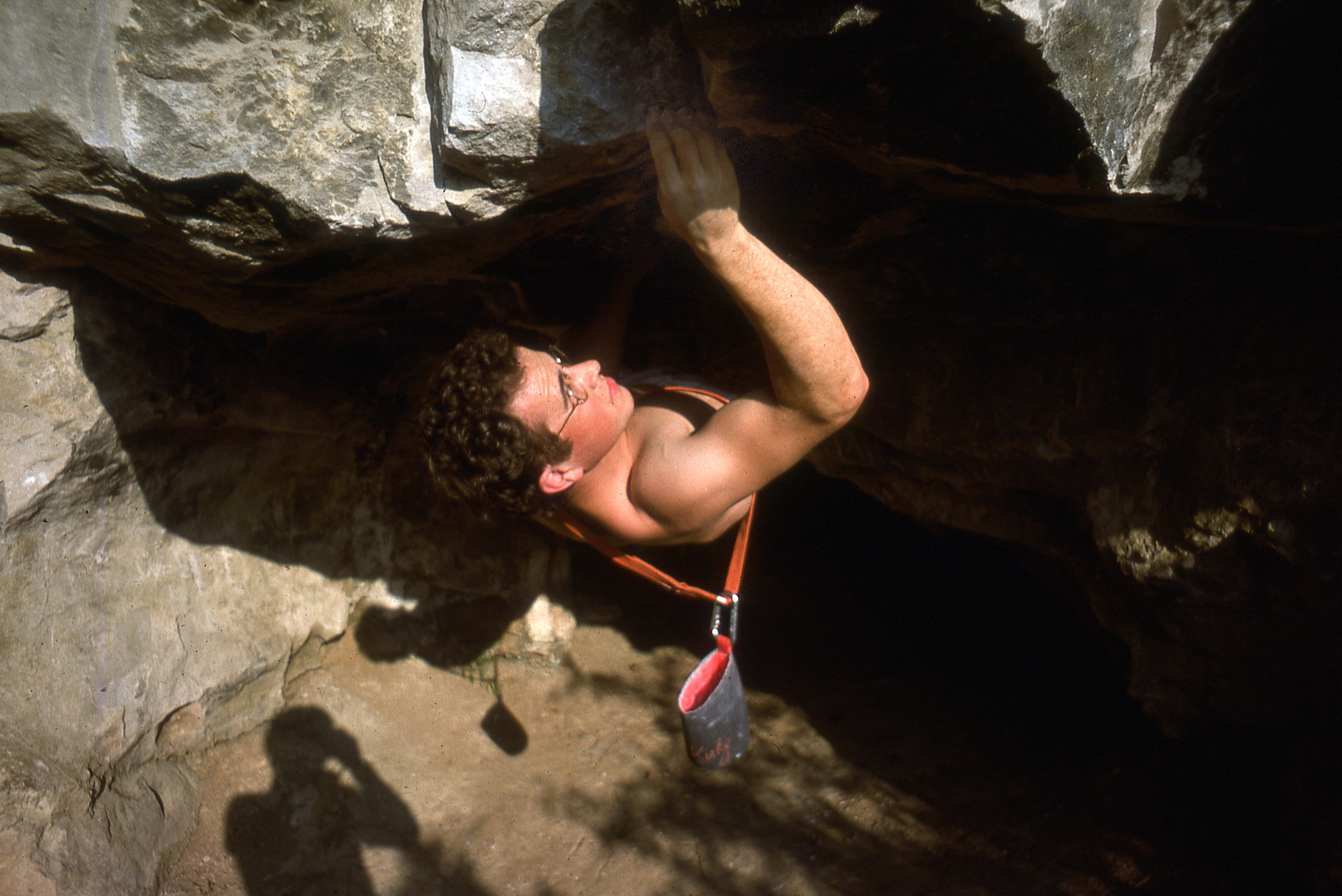
Now we arrive at the beginning of the recessed bays that line The Promenade starting from the distinct Mineshaft where it all began more than 100 years ago. This is not the best

bit of Stoney but near the bottom of the chimney on the right is an overhang, the entrance to a short piece of cave which always stays dry and is the location of the now legendary Tom’s Roof. The classic problem here involves a good hand jam and bringing your feet of the ground so that your body can lean backwards a few feet off the ground, so low in fact that you could almost survive landing on your head. Then you reach backwards to a good hold which fell off and was famously glued back on by Tom. Now the hard bit is releasing the jam to unfold horizontally which involves huge stomach muscle strength. It was something to do on a rainy day.
Left of this is the wall that goes down the right side of the bay which contains the magnificent Froth and has now been called Dead Banana Bay which is quite a good name really. This side wall is steep and Tom, accompanied by Ted Rogers climbed a direct line up it called Hercules. It is given E4 5c and a scarey description but I rather recalled that it was quite steady. Then Tom and I climbed the arête to the left called Beanstalk at E3 5c, a route which looked better than it was.
Dead Banana Bay
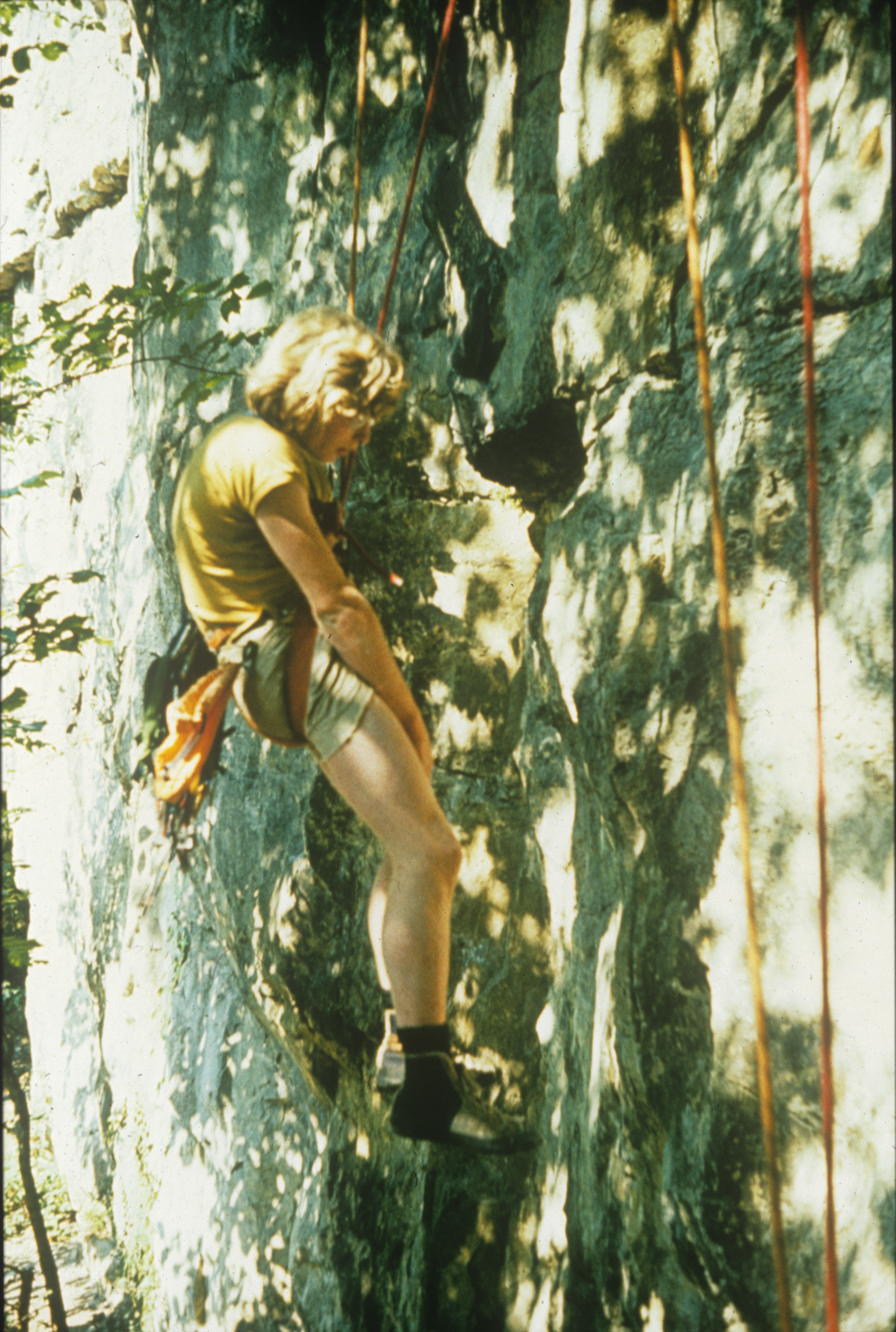
Now, we get round to the wall beneath the traverse line of Froth, a fine wall which boasted Dead Banana Crack, a fine route indeed but there was another fine line on offer to its right which I had looked at and the following Saturday was driving out to find somebody to hold the rope whilst I had a go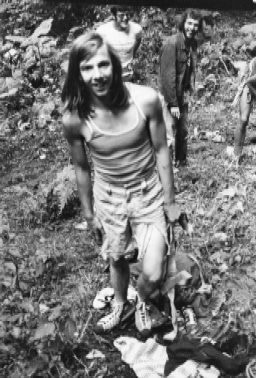

Frisco Bay
The crag looms up about here with magnificient walls and climbs. Originally the big route was Medusa both steep and bold. Again, Tom surprised us by climbing the wall to its left which was even bolder and quite committing. A mutual friend was Bruce Andrews who was tall and his wife Doris who was quite small and it was indeed her who belayed Tom on this historic and the eponymously named route of Wee Doris.
We all targeted this as a climb to repeat but it was down to the 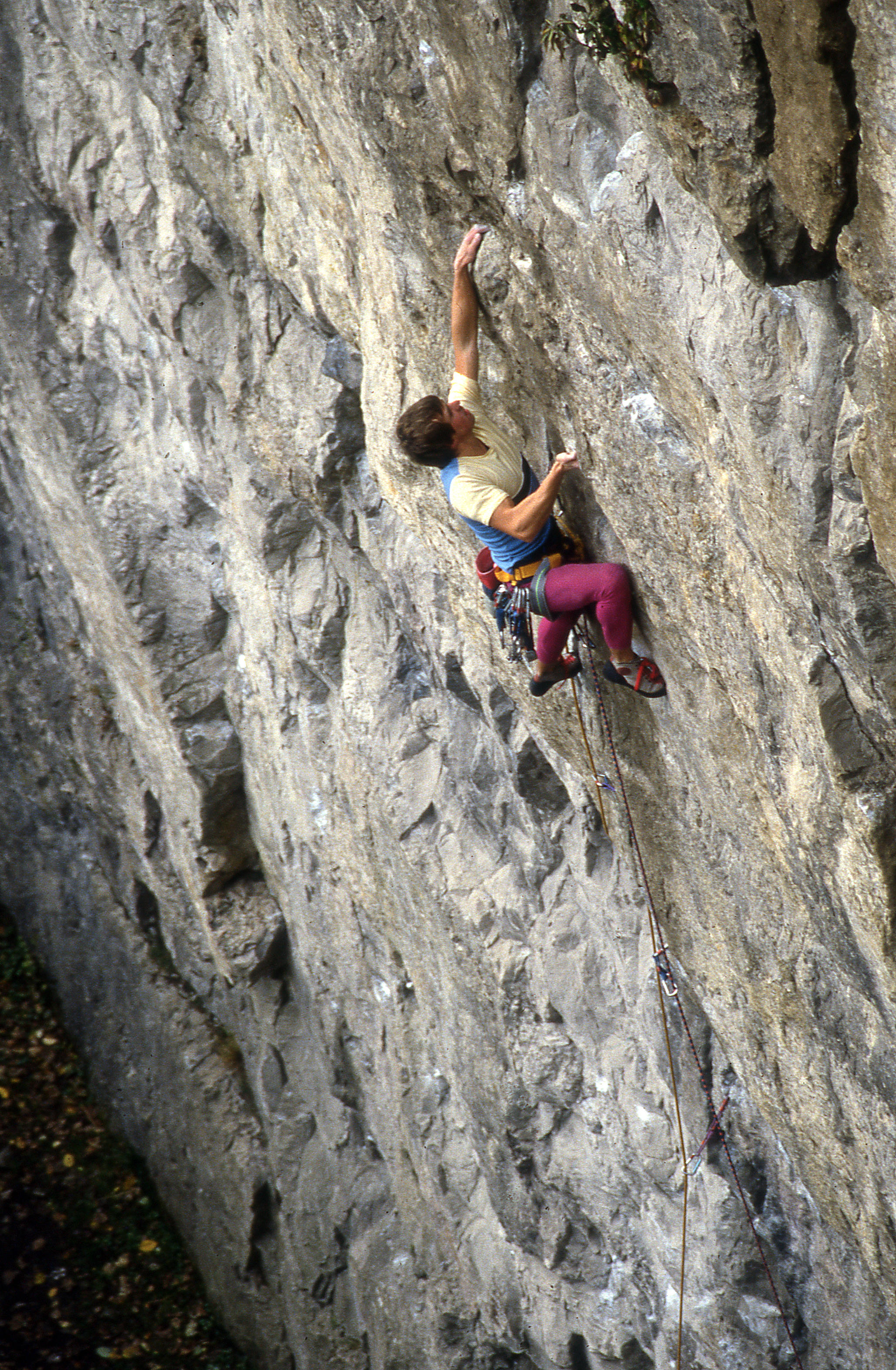
From the early part of this era Tom set up and led the steep bottom pitch of Pickpocket with a peg for aid and I did the top pitch with a nut for aid. Andy Parkin and John Fleming climbehthe bottom wall free in 1976 and Ron Fawcett the top one later.
Minus Ten Bay

My first memory of this area, when I was 15 years, was following Dave Mellor of Windhover fame up Minus 10 on which he had to give me a tight rope. Subsequently, I must have soloed it a hundred times over the years, barefoot, carpet slippers, you name it; not that I was grumpy about struggling on it as a child. I also added a traverse pitch to the right near the top, a perfectly pleasant stroll which we called The Great Escape and is now included as an alternative finish.
The wall of Minus 10 was popular for many as it stays drier for longer and has become a favourite bouldering venue largely for this reason. Tom did a new route up the steep wall right of Minus 10 which he named Traffic Jam at E5 6b and had an interesting hand swap-over in a letter box shaped hold quite high up. Some time later, on a particularly wet day, Tom and I resorted to top-roping it just for something to do and we rigged a top

to bottom round the tree at the top. Tom did it first and whilst lowering him off I gave him a thrill by letting him drop most of the way and putting on the brakes just in time for his toes to just make a small impression in the ground. When I did it and was being lowered off he shouted: “OK – got you. “Yes, ok Tom, I believe you” and I didn’t let go of the rope all the way down, much to his annoyance. If you think I was bad then you would need to know of all the dirty tricks he played on me which belied the innocence that he exuded. His favourite was dropping small stones down my neck as I was
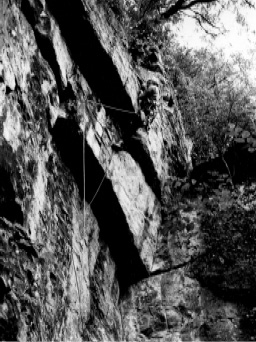
finishing a pitch and on one occasion as I came over the top of Golden Gate I found him laid in the grass looking at flowers with the rope in one hand, unbelayed. I know it wasn’t a hard climb but I might have jumped off for fun.
Towards the right side of this wall is a nice little crack called Double Scotch, E2 5c, climbed by Mouse (M) Barnicott) whose first name I never knew. He was one of the North Staffs contingent, small and wiry and an ideal build for steep rock. He turned up one day in a vintage Mark 8 Jaguar, a huge saloon with running boards and flying front wings. He’d just bought it for about 50 quid and it did no miles to the gallon and was a reckless decision as he had no money but it was big enough for him and his girlfriend to sleep in.
Right of that again is a steep wall where I bumped into Tom early days and belayed him whilst he did the first ascent of Pygmies Walk Tall.
Pearly Gates
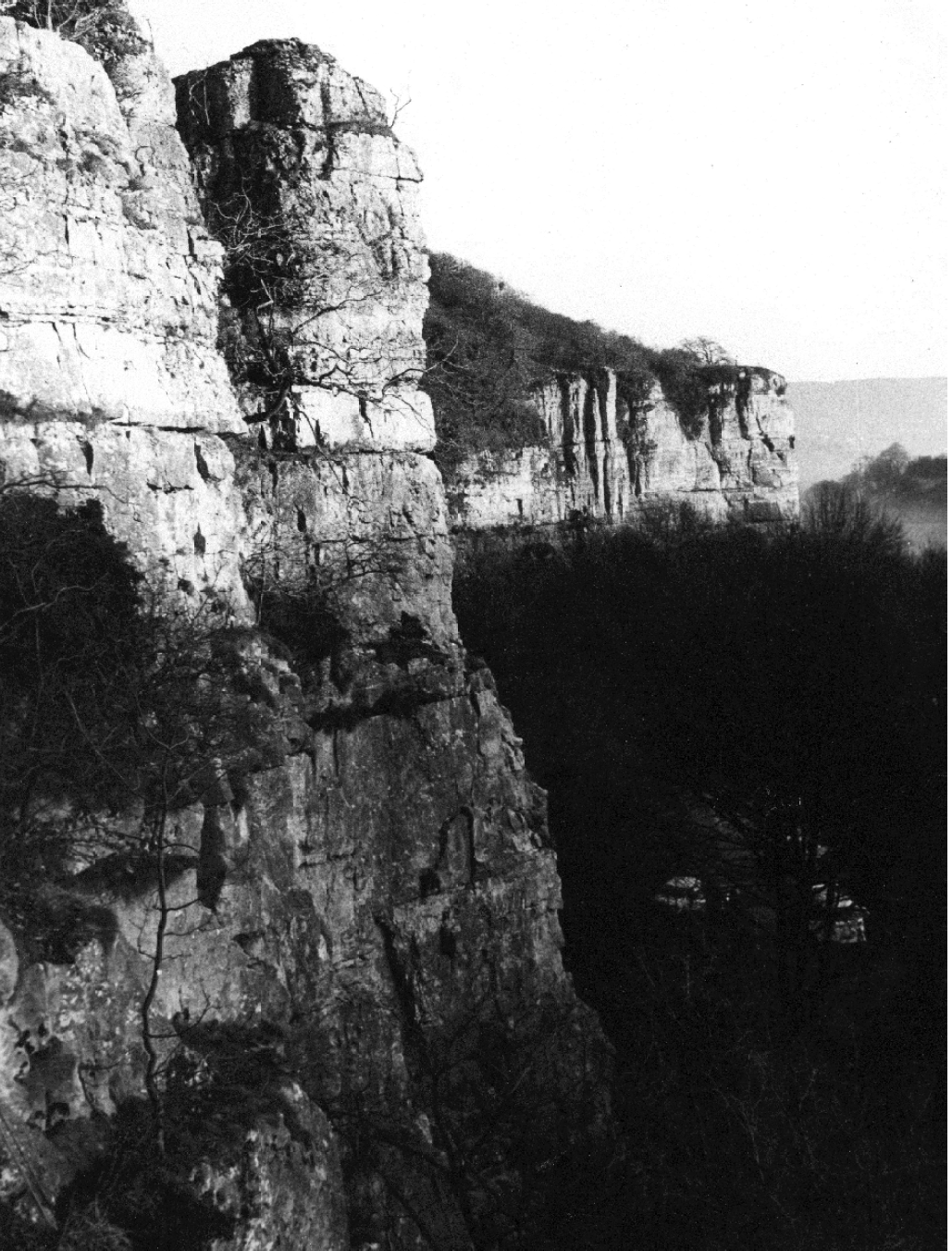
Pearly Gates itself is an exceptionally good route for its grade, well-protected, pleasant climbing and wonderful exposure on the upper arête. Neither Tom or I did much in the way of new routes there and my main memory is of soloing Gabriel in Hush Puppies one evening which has a traverse right quite high up. This involves a long step across and as I did this my foot slid across the ledge and I somehow didn’t fall off. Those ‘nearly’ moments never quite leave you. Jack Street did his noted solo ascent of Solitaire up the right side of this wall which was a brave effort. Apart from Fingal’s Cave being our early bivouac site we didn’t give it that much attention. Not much new routeing went on here in the 1970s apart from Martin Taylor’s Ben up the wall left of Gabriel at E2 5c
Prayer Wheel Wall
In the days when you could drive up The Promenade, before the threat of New Age Travellers moving in after being removed from Horseshoe Quarry, Prayer Wheel Wall was as far as you could get by car and it was not unknown to be still sat in the car belaying your partner.

However, for better or worse, the local council blocked off the entrance.
To the left of Fingal’s Cave the rock is broken and heavily vegetated and whilst it was fun to explore new routes, repeating them is hardly worthwhile until you get to the historical Minestrone, often climbed as two pitches due to the traversing involved. The best climbs there are on the main wall where Padme is the dominant feature. This area was the reserve of 1950s exploration by the likes of Jack Soper, Pete Crew and Barry Webb.
I was amused and pleased to see that Brassiere Strap is still included in the latest Peak Limestone North guide. I only ever saw it climbed once, probably the first ascent by Chris Jackson and Graz Hawker in 1963. It is a largely grassy ledge route but symbolic of those early days. There was very little added there in the 1970s. Om used to be a nice solo, even in carpet slippers until another entrance to Carls Wark cave was opened up which would have meant a fall, even a short one, uncomfortable. Apart from that, I only added the top pitch to Padme which is in a nice position but a bit scrappy.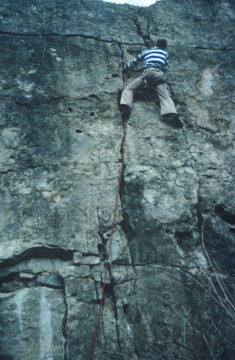
Omelette E3 5c was also added up the wall left of Om in 1976 by Steve Bancroft who also added the visionary-titled Looking Through Gary Gibson’s Eyes in 1979 with the usual cast of thousands
Carl’s Wark
The driveway of The Promenade ends below Prayer Wheel Wall and to continue you have to traverse a narrow footpath with dangerous drops below and above, first, Ivy Buttress, then Triglyph to eventually reach Shining Cliff and Mortuary Steps which heralds the beginning of The Quarry but instead of that, below Prayer Wheel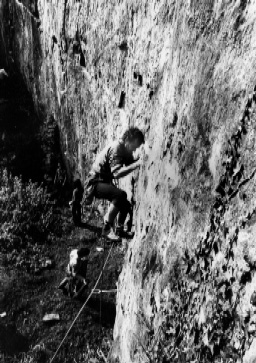
There were other significant routes to come with Tom doing Bubbles Wall in 1975 and Gabe Regan added Scarab, with Ron Fawcett adding a direct variation to the latter. Later, in 1981, Jerry Moffatt added his classic Black Kabul in 1981.
Ivy Buttress

There’s not much to be said about this buttress as it is small and rather insignificant with a few pleasant little climbs the best of which were done by the late 50s early 60s roup. I just recall doing one new route there with Ernie Marshall which appears to be now called Marasmus E3 5c; not important. Ernie was a noted climber from the 1950s with first ascents on such crags as Gardom’s. Though he was older than me and Tom, he often joined us for forays all over the Peak.
The Triglyphs
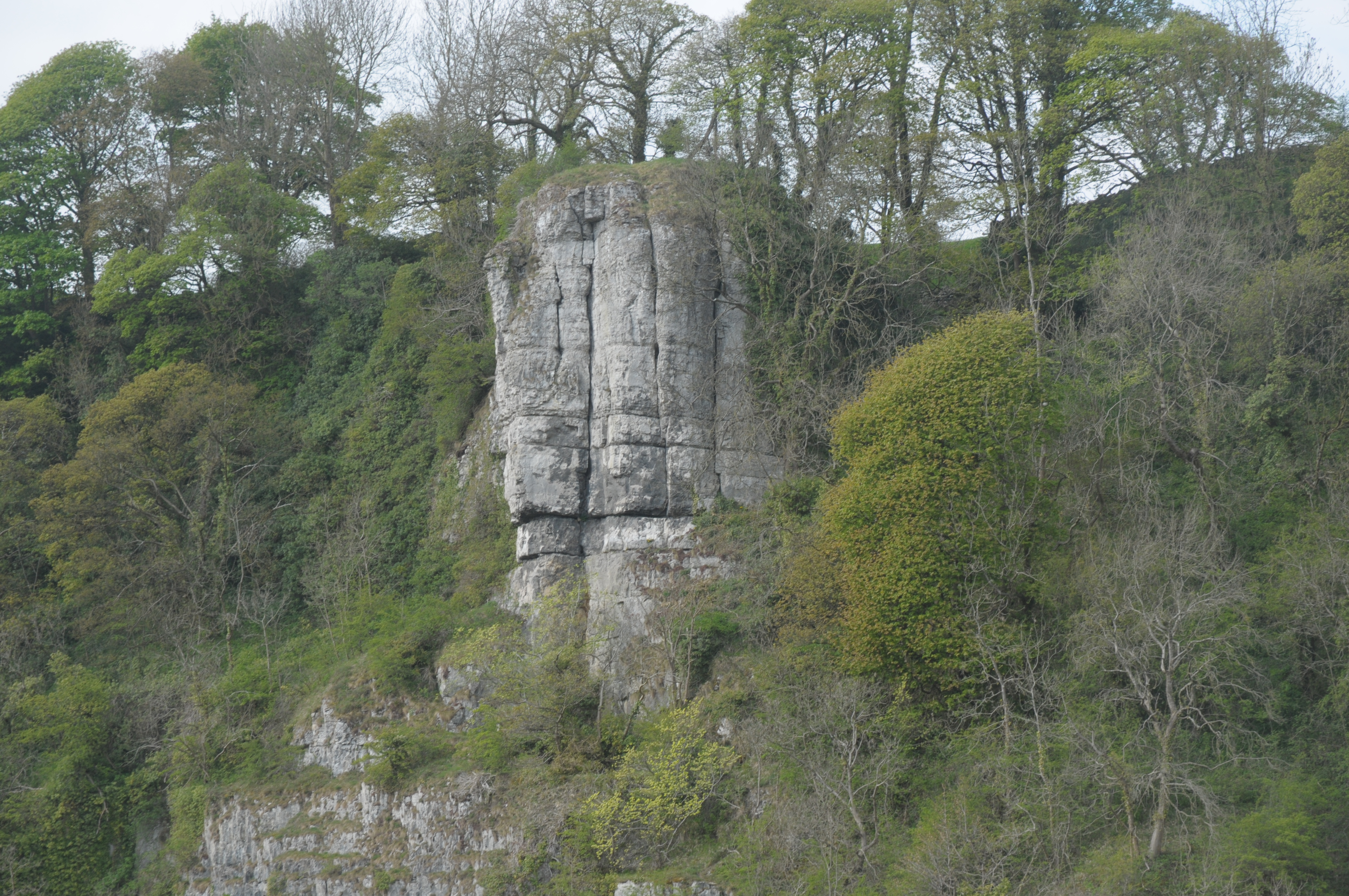
The meaning of Triglyphs is ‘a tablet in a Doric frieze with three vertical grooves alternating with metopes’, which appropriately sums up this rather imposing buttress that protrudes out of the hillside distinguished by its three prominent cracks of How the Hell, What the Hell and Morning Crack from the 1950s when the odd threaded chockstone would have been the only protection. The central crack of What The Hell was always considered to be the most serious undertaking and in the 1962 West guidebook was given Extremely Severe, and it felt like that as my introduction to Stoney as a 15-year old apprenticed to Jack Street. The left-hand crack, How The Hell was given a mere Very Severe but oddly, today, that is now VS 4c whilst What The Hell has been demoted to VS 4b. Situated at the top of the hillside with considerable exposure and rock of mixed quality, this has always been a place for a feeling of adventure.


Shining Rock
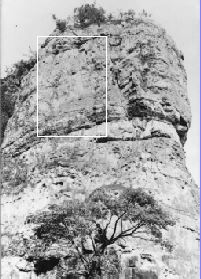
At the end of the hillside, referred to as The Doldrums by Graham West in his 1961 guide, we arrive above the junction of the main road with that of Eyam Dale on the right the right which is why the hillside turns sharp right here and is significantly quarried and always referred to by climbers as The Quarry. The power station there was installed after such as Jasper was climbed in 1963 though I have failed to find a pre-power station photo. The Quarry begins with what climbers refer to as say Mortuary Steps Buttress though its historical name is Shining Cliff. It is indeed a fine buttress atop a lower chossy but very steep base and is distinguished by a fine groove which is itself

the line of Barry Webb’s Mortuary Steps with lashings of exposure. The front face is a wall with a fine crack line which was first climbed by Dennis Gray and John Ramsden in the 1950s with some aid and was duly recorded in West’s guide as A1 but subsequently free climbed.
On the hanging arête to the right of Mortuary Steps is a mixed groove but in such an exposed position that it grabbed my interest and in 1979, I attempted it with Tom holding the ropes for a change. I climbed through the lower overhang and into the lower groove where I placed a runner but felt pumped out and came down to fight another day. This was my route and I wanted another go. However, Tom went back a week later with Ernie Marshall and leted the pitch. It was called Cardiac Arrest E4, 6a.
The Quarry
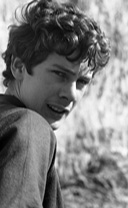
Oddly enough, we never got stuck into the fine wall left of Mortuary Steps but Bob Dearman climbed two routes, The Morgue and Speed Kills with some aid that was subsequently freed by Tom. Left of this the walls are overgrown and though there are some patches of good rock, it is not memorable until you finally get into the Brown Corner bay with two fine steep walls at right angles and some of the best climbing at Stoney. Brown Corner was the first sinificant free climb there by Barry Webb and was held in awe until Dave Sales repeated it in 1964. Other free climbs appeared as already recorded in the early Cioch section and by the 1970s was becoming a focal point. In 1976, I managed to climb the wall just left of Brown Corner with Millionaire Touch E4 6b. I had preplaced a peg at about 20 feet and after clipping it lowered down for a rest. I purposely lowered quite a way down so that I had to reclimb back up to the peg and past it to complete the climb. On refelection, I should have lowered a few more feet to the ground and reclimbed from there which would have made little difference. There is also a reference in the 1987 guide that ‘…a rest and belay in the tree were possible’ but I certainly didn’t and never saw anybody else do that; though the history in this guide is full of cafe chit chat.

Whatever, there were new boys on the block. Steve Bancroft’s contribution here was Emotional Rescue in The Quarry in 1980 with John Stevenson which he graded E4 6a, 5b. This took the imposing wall between Damocles and John Peel using a side runner in the latter to protect the lower wall. Young Ron Fawcett was now a regular there and he eliminated the nut for aid that I used a free version of the old aid route Damocles.
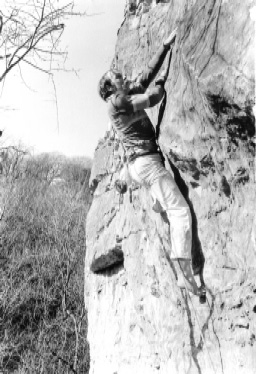
Either Al Rouse or Tom free climbed Cabbage Crack depending on which record you read and I was very fortunate to grab Oliver which takes a very fine central line up the left hand wall.
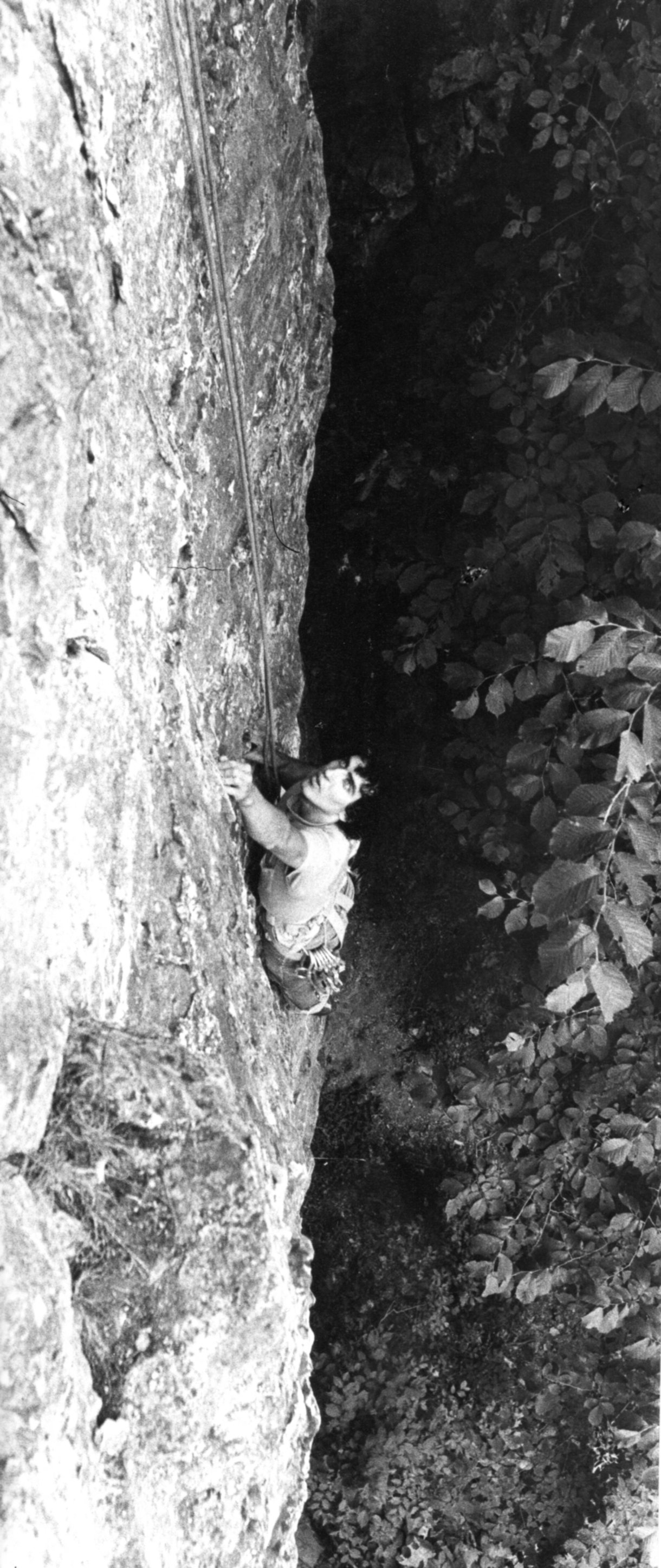
I had abseiled down it and removed a flake off that was loose anyway, that’s what you did on limestone. This was recorded in the 87 guidebook by the cafe historians as: ‘Practised for months. Blatant ‘prised flake’ in the middle of a blank wall. Instant classic, often failed on. Now considerably harder with several holds missing.’ Apart from the fact that I did remove a loose flake off the rest is weird rubbish. After Tom had nicked Cardiac Arrest, I wasn’t going to give him another one so the idea that I practised it for months is fantasy. Tom would have grabbed it straight away and with that in mind, I went out midweek with John Stevenson after having previously made just one abseil inspection. I failed that evening and then went out with Tom at the weekend and did it first go with Tom following. In 1989, I top-roped it several times as training for the Vets Competition at Leeds that year and it was exactly as it was on the first ascent; no missing holds.
Left of Oliver, Ron Fawcett climbed The Heat, an E5, 6a in 1980 with some desperate and bold moves. Like a few other outs at Stoney with poor protection, you rarely saw them repeated. Left again at the arête, Jerry Moffatt added Helmut Schmitt at E6, 6a to which Fawcett added a direct variation. I finish the main crag as I started with a poor route. up the left side of the arête left of Cabbage Crack.
Stoney West /Cucklet Delf
On the outskirts of the main crag was Cucklet Delf, Stoney West, Horseshoe Quarry, Hidden Quarry and Goddard’s Quarry. Strictly speaking Horseshoe was Furness Quarry and Hidden some other name after the extraction company but in conversation I called them Horseshoe and Hidden which meant something to me and Tom. Cucklet Delf which has a quaint old English ring to it was actually named after a chap called Cucklet who farmed the upper meadows. What we always called ‘The Quarry’ has now taken on the adopted name of ‘Electric Quarry’ but when we did Jasper in 63 the electricity station wasn’t there.
Both Cucklet Delf and Stoney West were really pleasant places to get away from the throng though you can do that on the main crag these days. Neither place has outstanding routes but both have a choice of nice little climbs such as Paul Nunn’s Swansong and Chris Jackson’s Tomarwa Groove which is a bit of a thrutch, Con Carey’s Cucklet Delf Eliminate and Dave Knighton’s Candy Store Rock, both at HVS Then there is Turkey Vulture Crack which is a nice HVS over 60ft long. There are quite a number of routes in the middle grades though in 1981 Paul Mitchell added Northerners Can’t Climb at E5 6a which gets two stars in the guide.
Quarries and Trespassing
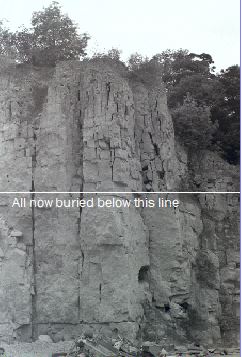
Before Hidden Quarry closed, Tom and I foraged round there and did two good climbs. I was recently asked by currently resident climber at Stoney, Colin Hughes about these routes which he couldn’t find so, as I knew the buttress supported Farnsley Lane I imagined it must still be there so I went to find out and discovered that it had been half buried, back in about 1988. I’ve attached some before and after shots. The two routes were called Sniffer Clarke and Big Chiv. I led the one with the thin crack start and Tom did the other which involved thrutching up a chimney with arm bars. This was back in the early 70s when the quarry was still active and we were trespassing on a Sunday. Somebody must have spotted us or we’d triggered an alarm because as we finished one route, a car sped up and a chap got out in a fluster looking all round but as we were laid in deep grass now on the top he couldn’t see us. We were unkindly amused that we had spoilt his Sunday dinner.
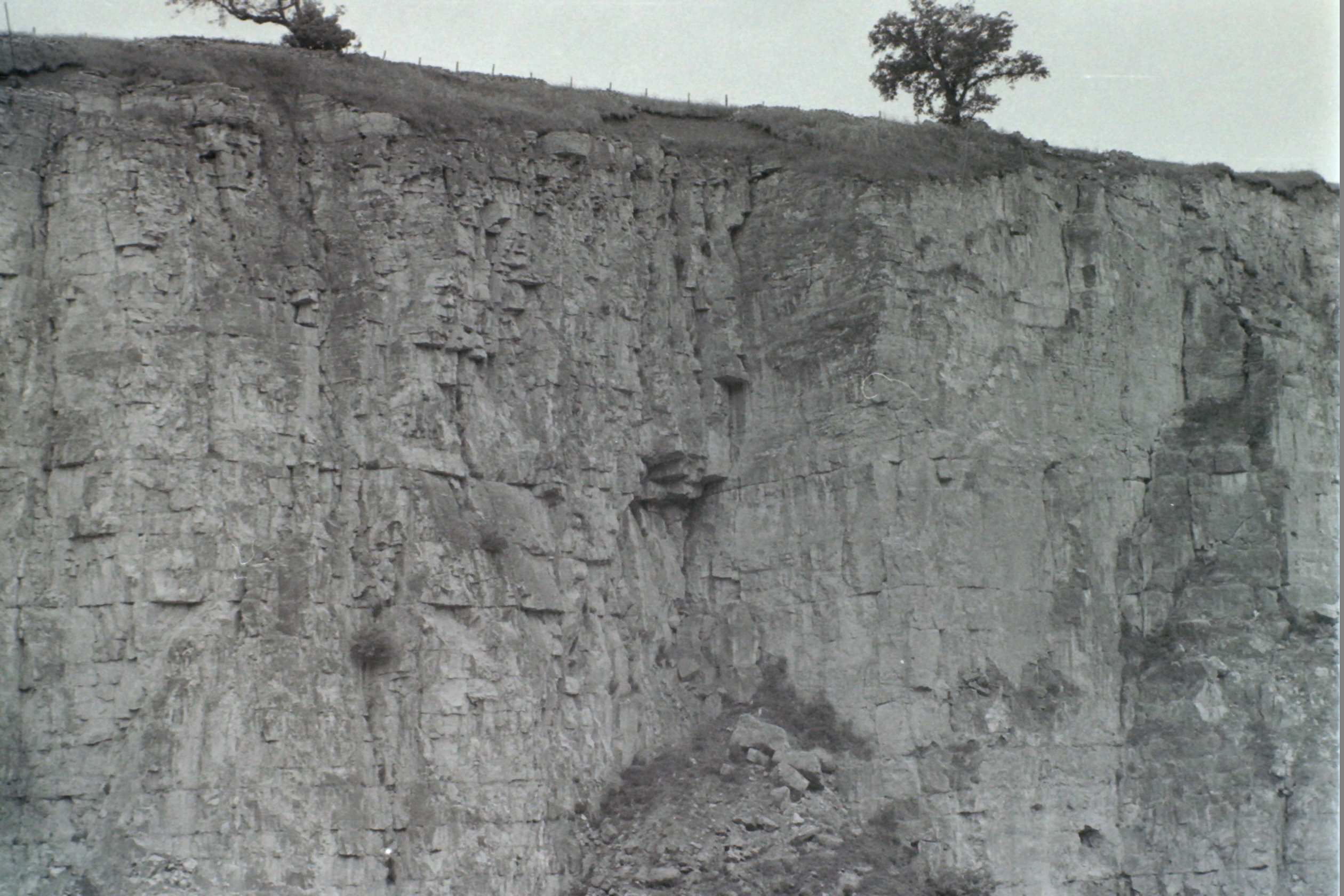
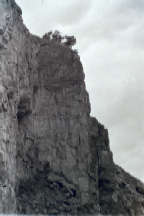
The other illegal quarry activity was in Goddard’s Quarry opposite Garage Buttress which had a distinctive winking corner in that it caught your eye every time you were up on Windy Buttress. So, getting up at 4am one June morning, and accompanied by the late Tim Brown, a local Sheffield Telegraph reporter and climber, we went to Stoney and climbed said corner with a large flake crack high up. The first few feet were dirty and then as a complete surprise the rest was on fabulous solid rough textured limestone. It was a nice climb, maybe good HVS and as Tim seconded, the first chap turned up for work so it must have been a Saturday morning. He then opened up a hut almost opposite us and stood in the doorway looking out and stretching his arms. Apparently, most people never look above a 30° angle. Had he done so he would have seen Tim quietly finishing the climb but again we got away with it. Sometime later on a sodden Sunday, Tom and his wife Kath called on us and we were very twitchy at not being able to climb on what was otherwise a warm day. So, eventually we thought ‘sod it’ and went out anyway to get wet and ended up in Goddard’s Quarry where we climbed the wall left of the winking corner in two pitches. Again, it was probably only about HVS but in the rain and without prior cleaning we had to move carefully on what was again really good rock, especially on the upper part. Eventually, they blasted most of the right wall of the corner but the inside corner is still visible.
Horsehoe Quarry
The names Horseshoe and Hidden Quarry came into being by me talking to Tom about the places which is how I suppose all place names come into being. We just didn’t know that they already had names.
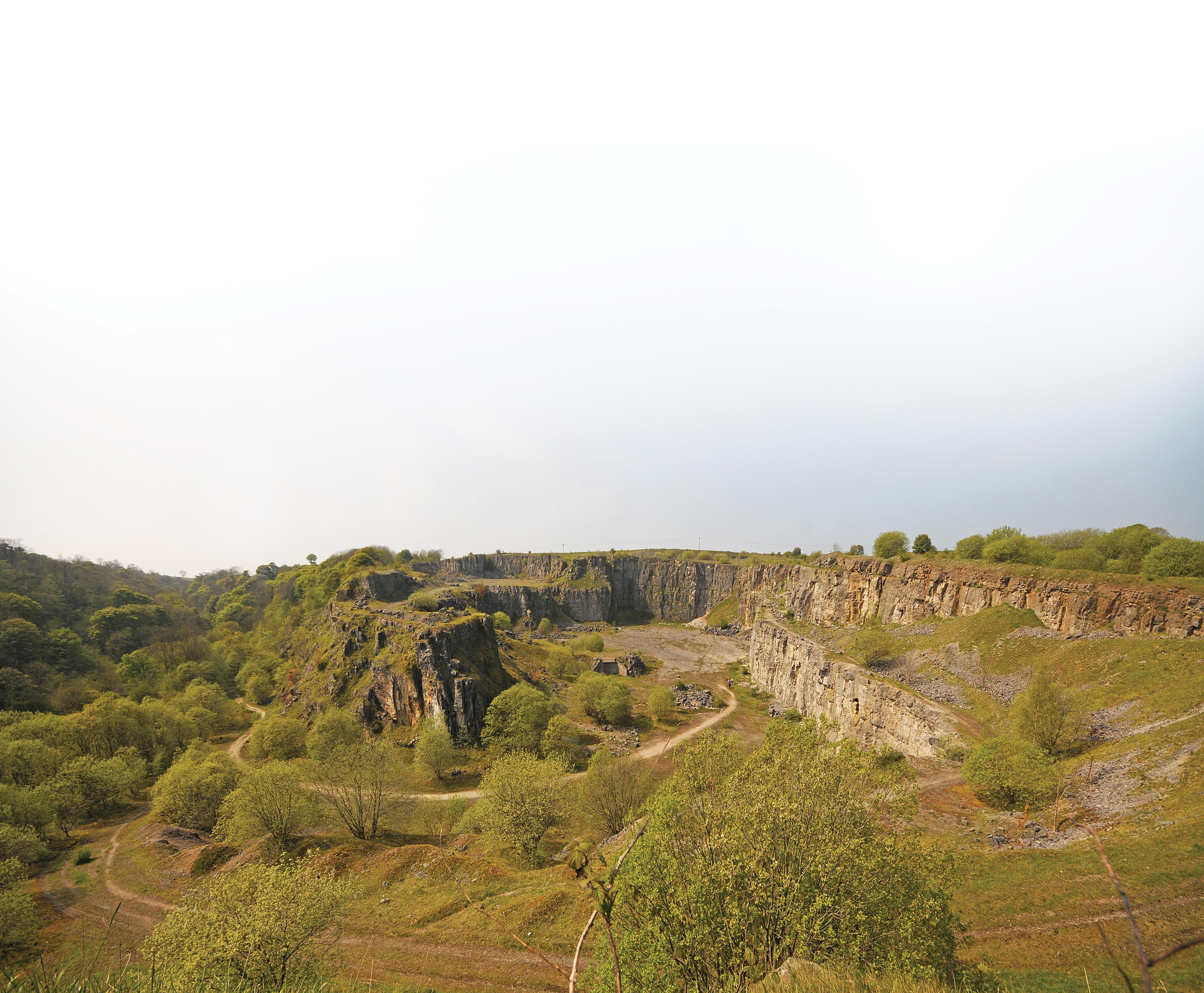
After 1980, when Tom and I were doing some caving, we went to Horseshoe Quarry where a small cave entrance was visible high up. Rather than abseil down, we climbed up to the cave, explored it and then climbed to the top of the crag. The rock was actually quite good, very dirty with lots of grass but solid, off vertical and about Severe. It would make a perfect wall for a training school wanting to do two-pitch climbs. I note that this route is not even shown in the latest guidebook. It is probably the best Severe in Horseshoe; the only Severe. Subsequently, Chris Jackson, noted for his ascent of Armageddon, climbed the delectable Chocolate Blancmange Gully with Roy Small and Bob Conway.
End of an era
Tom didn’t really come back from that injury though he did almost summit on a phenomenal new route on the East Face of Cerro Torre in Patagonia after not climbing for a year which is itself a testimony to his great natural ability.
In the winter of 79/80,
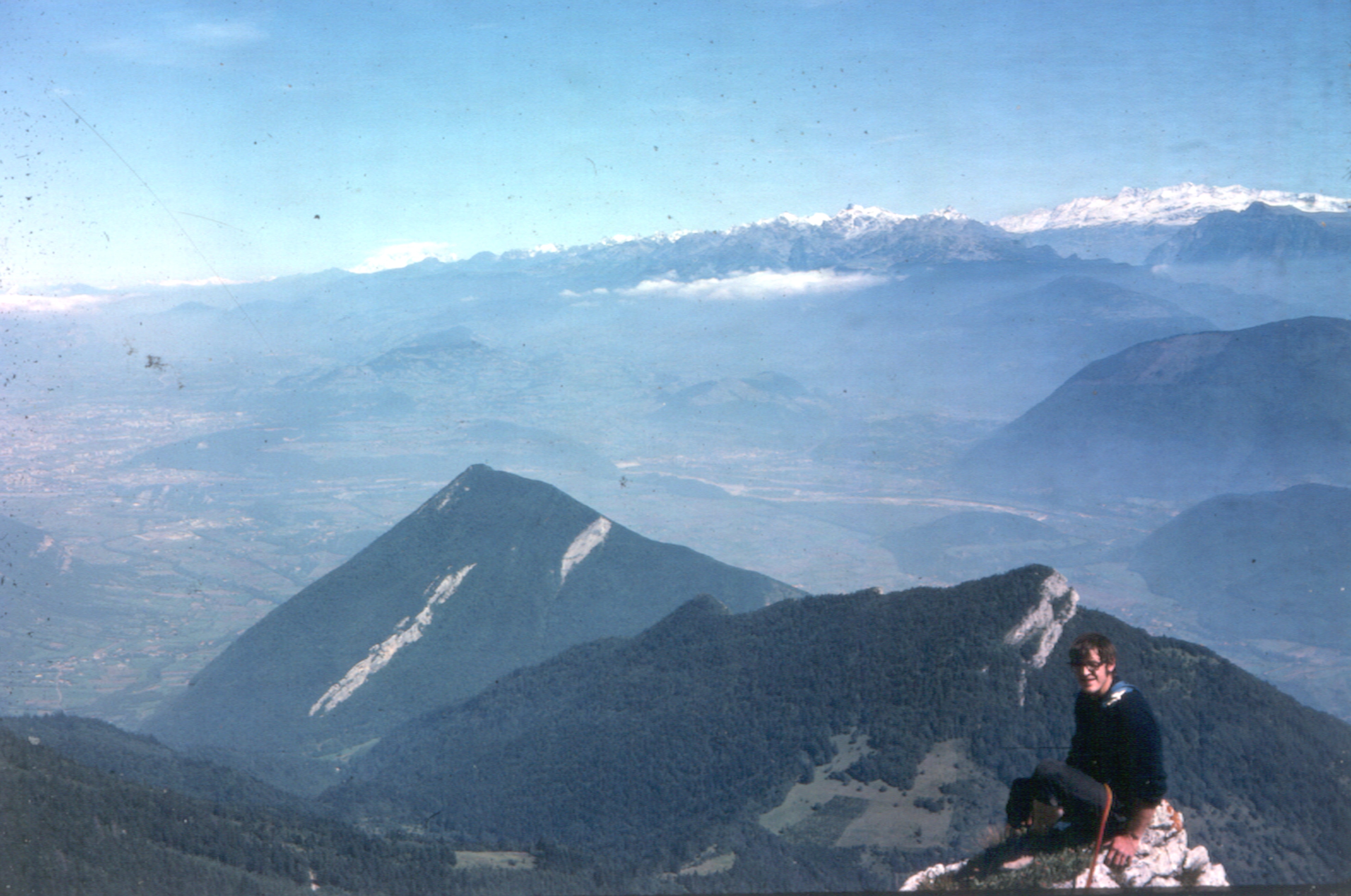
Tom rekindled his original interest in Stoney which was caving, the reason he had first visited there as a schoolboy. I had done the first pitch of Little Plum with one point of aid and we were trying to eliminate that one cold day when we got fed up and decided to have an adventure instead. When we had done Big Chiv and Sniffer Clarke in Hidden Quarry, we noticed a part buried cave entrance close by and we went to explore that with some success. The quarry people seemed to bury ground level cave entrances maybe as a deterrent to people like us. However, after a bit of digging, we managed to enter a substantial rift passage though much to our surprise it was dark. We hadn’t thought to take a torch but we returned and the thrill of cave exploration was instilled in us; we became cave diggers. What made it worse was that in our first winter of exploration we made a lunatic dig under a huge collapse, propping as we went to eventually lead to a substantial stream passage now known as Streaks Pot included in the caving section elsewhere on this site.
I made a point of climbing every month whilst Tom stopped altogether. It was the end of a legend. Nobody before or since had made such an impact on climbing at Stoney.
Time to move on

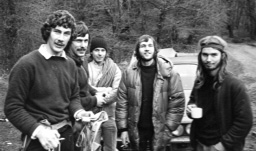
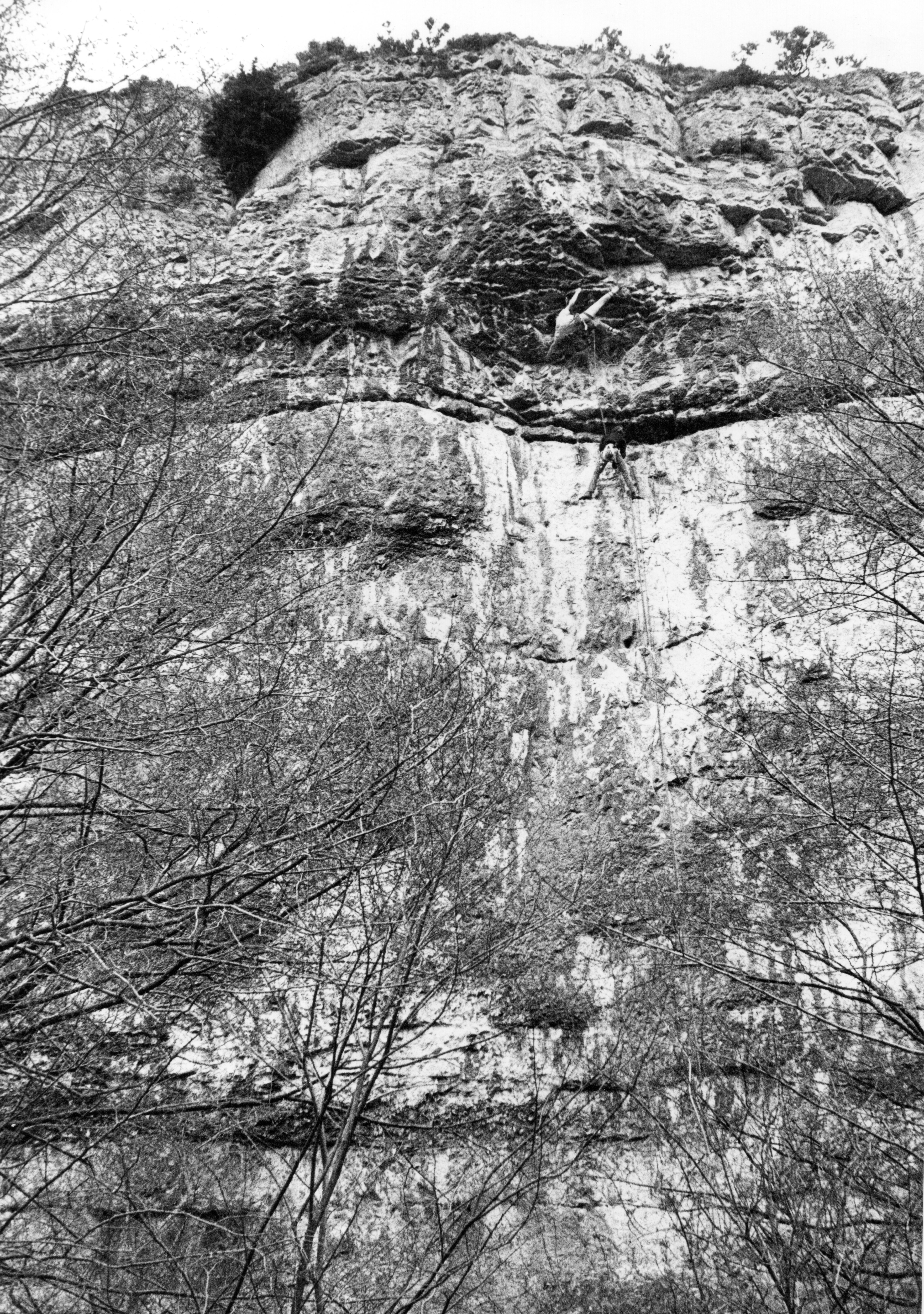

Acknowledgements and apologies:
Thanks go to Ian Smith and Phil Kelly for proof reading etc. Also, thanks for the use of Niall Grimes’s photos which he took whilst preparing the BMC guidebook Peak Limestone North and to all those who have granted permission for their photos to be used. I apologise for a few that have no credits and will gladly correct this if they get in touch via this web site.
Following this are two articles. The first was originally published in High Magazine 244 in 2003 and is a retrospective of Stoney by Keith Sharples. Secondly is another historical piece the text of which first appeared on UKClimbing in 2012, written by Mick Ward. Keith Sharples has also agreed to write the developments from the early 1980s to the modern day.
Corrections: Any suggestions for corrections will be gratefully received and appreciated. Please send to the website.
© Geoff Birtles 2018